Paul van Yperen's Blog, page 56
March 17, 2024
Photo by Steve Schapiro
American photographer Steve Schapiro (1934-2022) photographed key moments of the civil rights movement in the US such as the March on Washington for Jobs and Freedom or the Selma to Montgomery marches. He is also known for his portraits of celebrities and film stills, most importantly from The Godfather (1972) and Taxi Driver (1976). In Hollywood, he worked on more than 200 films.
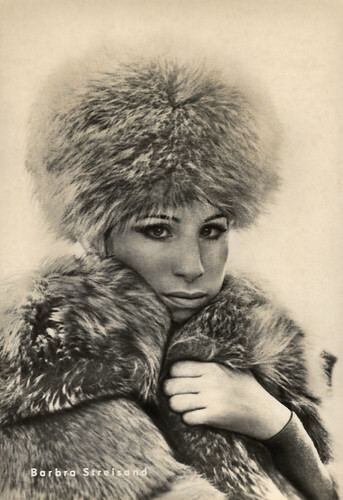
East-German postcard by VEB Progress Film-Vertrieb, Berlin, no. 186/70. Photo: Steve Schapiro / Columbia. Barbra Streisand in Funny Girl (William Wyler, 1968).
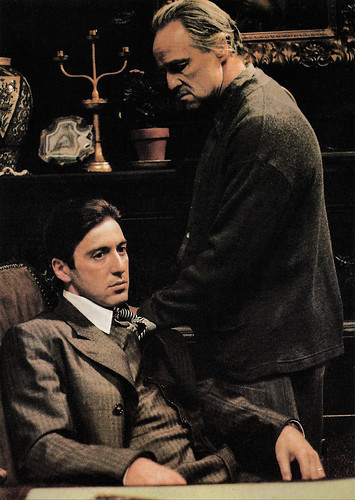
British postcard by Star-Graphics, no. S 91. Photo: Steve Schapiro. Al Pacino and Marlon Brando in The Godfather (Francis Ford Coppola, 1972).
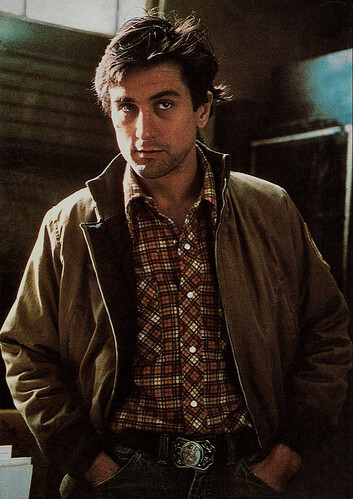
Italian postcard by Edizioni Beatrice D'Este, no. 20 162. Photo: Steve Schapiro. Robert De Niro in Taxi Driver (Martin Scorsese, 1976).
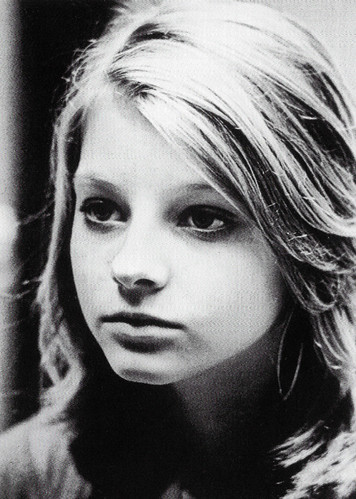
British postcard by Music & Movie Stars Ltd. Publishers, no. MMS 036. Photo: Steve Schapiro. Jodie Foster in Taxi Driver (Martin Scorsese, 1976).
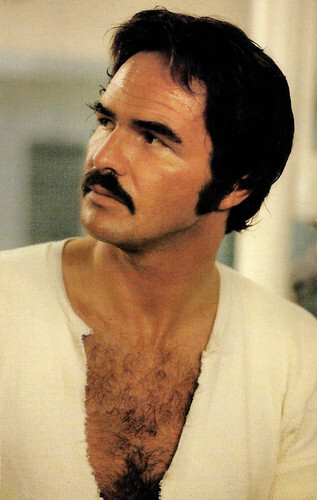
American postcard by Coral-Lee, Rancho Cordova, CA, no. Personality #81, SC176971063. Photo: Steve Schapiro / Sygma. Burt Reynolds.
Photojournalist and real activist
Stephen Albert Schapiro was born during the Great Depression, in 1934 in Brooklyn and grew up in the Bronx. His parents were David Schapiro, a stationery store owner in Rockefeller Center and Esther (Sperling) Schapiro who worked at her husband's stationery store.
Steve discovered photography at Summer Camp at the age of nine and continued to take pictures as he grew up. One of his role models was the French photographer Henri Cartier-Bresson. He sought to emulate his style as he roamed the streets of New York. Schapiro attended Stuyvesant High School and Amherst College, from where he later transferred to Bard College. He graduated from there in 1955 with a degree in literature.
In 1960, Schapiro took lessons with W. Eugene Smith, an influential photographer during the Second World War. Smith taught him how to develop his own views of the world and photography. Schapiro even embedded with Smith for a time in his Manhattan loft. He learned how to make prints and picked up some tricks of the trade, like showing two points of interest in a portrait, which Smith told him would make the viewer’s eye go back and forth and thereby hold the viewer’s attention. Schapiro's work reflects the influence of his teacher.
In 1961 Schapiro began working as a freelance photographer. His photos were published in Life, Look, Vanity Fair, Sports Illustrated, Newsweek, Time and Paris Match. Schapiro photographed jazz pianist Bill Evans, artist Andy Warhol , writer Samuel Beckett, heavyweight boxer Muhammad Ali, actresses Barbra Streisand and Mia Farrow and musician David Bowie , among others.
The political, cultural and social changes of the 1960s in the United States were an inspiration for Schapiro. He accompanied Robert F. Kennedy during his presidential campaign. He captured key moments of the civil rights movement such as the March on Washington for Jobs and Freedom or the Selma to Montgomery marches. For Life, he documented the scene of the assassination of Martin Luther King in Memphis in 1968. Schapiro not only worked in photojournalism and documentation but also became a real activist. This is, for instance, visible in his way of documenting the hard lives of immigrant workers from Arkansas he dealt with in 1961.
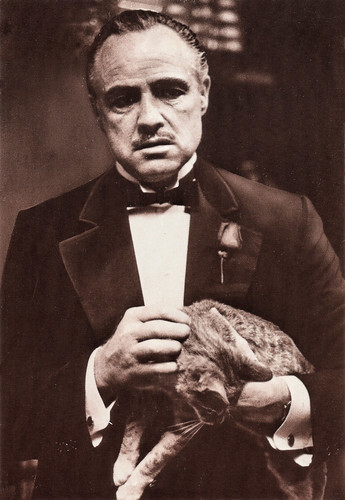
American postcard by Classico San Francisco, no. 136-183. Photo: Steve Schapiro / The Ludlow Collection. Marlon Brando and Cat in The Godfather (Francis Ford Coppola, 1972).
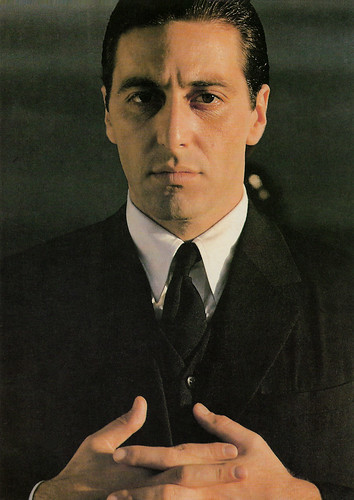
British postcard by Star-Graphics, no. S 89. Photo: Steve Schapiro. Al Pacino in The Godfather (Francis Ford Coppola, 1972).
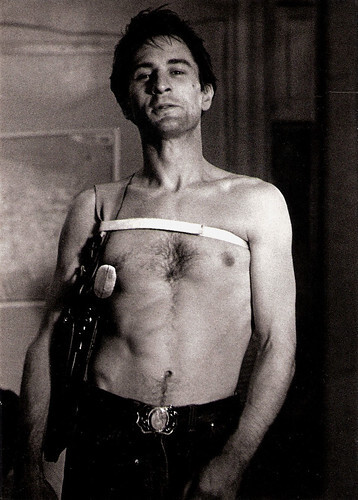
Belgian promotion card Taschenhen Gallery for the exhibition 'Taxi Driver - Unseen Photographs from Scorsese's Masterpiece'. Photo: Steve Schapiro. Robert de Niro in Taxi Driver (Martin Scorsese, 1976).
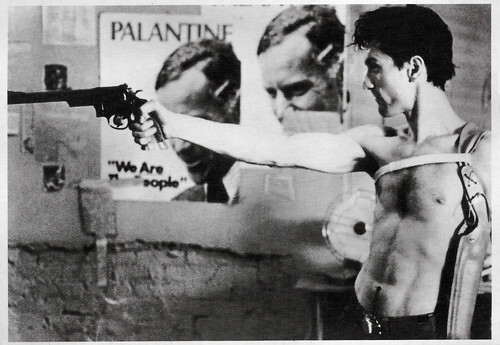
Canadian postcard by Canadian Postcard, no. A-5. Photo: Steve Schapiro. Robert de Niro in Taxi Driver (Martin Scorsese, 1976).
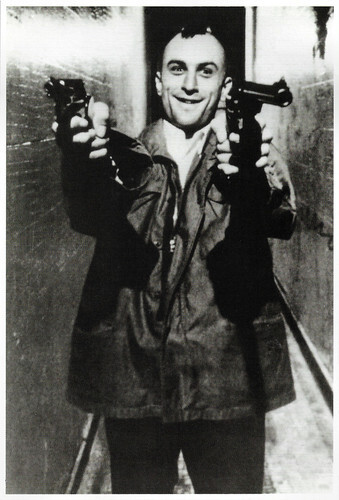
Vintage postcard. Photo: Steve Schapiro. Robert de Niro in Taxi Driver (Martin Scorsese, 1976).
Capturing key moments of modern American history
With the sharp decline in circulation figures for magazines such as Life and Look, the demand for high-quality photo essays fell from the end of the 1960s. Steve Schapiro moved to Los Angeles, where he photographed promotional material for film studios, artwork for record sleeves and portraits of well-known Hollywood stars, among other things. Having taken photos of Midnight Cowboy (John Schlesinger, 1969), among them also a famous one of Dustin Hoffman , he was hired as a photographer by Paramount Pictures.
He photographed on the set of the mafia epic The Godfather (1972) by Francis Ford Coppola with a cast including Marlon Brando , Al Pacino , James Caan and Robert Duvall. One of his photographs is of "Marlon Brando and the Cat". Rob Sharp in The Independent: "A man in his early fifties is dressed in black tie. He is lit from above, which throws his features into an intimidating scowl. The picture is completed – rather incongruously – by a young cat in his arms."
Schapiro was also present at the film set of Chinatown (1974) by Roman Polanski. His role involved being as unobtrusive as possible while the actors worked. As such, very little of what he produced was posed for. In 1974, he also shot the cover for the debut issue of People magazine: a portrait of Mia Farrow as Daisy Buchanan in The Great Gatsby (Jack Clayton, 1974).
Two years later, Schapiro was – by request of Robert De Niro – hired as a photographer on the set of Martin Scorsese's film Taxi Driver (1976). The chilling film situated in New York in the angry climate of the post-Vietnam era, became a milestone and DeNiro’s portrait of a trigger-happy psychopath with a mohawk is one of the greatest performances of the 1970s. As the special photographer on the set, Schapiro captured the film’s most intense and violent moments from behind the scenes.
During his career of six decades, Schapiro captured key moments of modern American history with his photos that also reflect his own social and human awareness. In 2022, he died from pancreatic cancer at his home in Chicago, at the age of 87. Schapiro was married three times. His first two marriages ended in divorce. He was survived by his wife Maura Smith, two sons, Theophilus Donoghue and Adam Schapiro; two daughters, Elle Harvey and Taylor Schapiro; and four grandchildren. Another son, Teddy Schapiro, died in 2014.
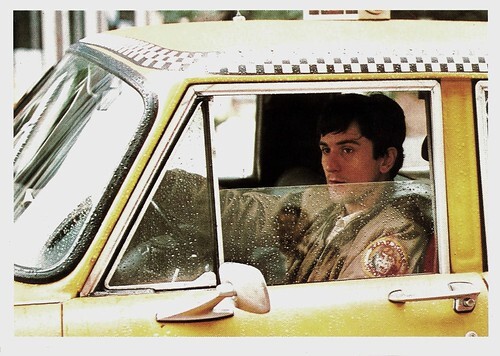
French postcard in the Collection Cinema Couleur by Editions La Malibran, Paris, no. MC 33, 1990. Photo: Steve Schapiro. Robert De Niro in Taxi Driver (Martin Scorsese, 1976).
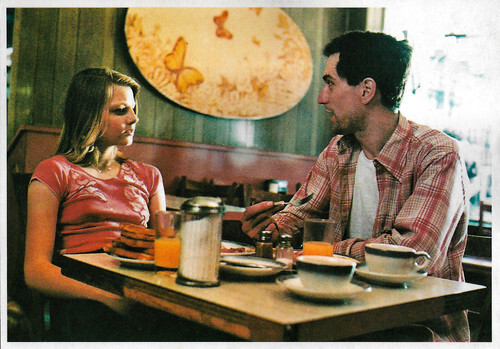
British postcard by Memory Card, no. 530. Jodie Foster and Robert de Niro in Taxi Driver (Martin Scorsese, 1976).
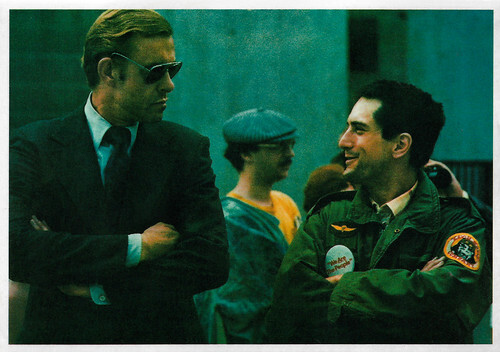
British postcard by Memory Card, no. 531. Robert de Niro in Taxi Driver (Martin Scorsese, 1976).
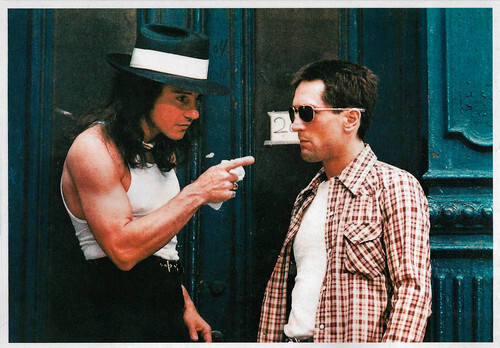
British postcard by Memory Card, no. 532. Harvey Keitel and Robert de Niro in Taxi Driver (Martin Scorsese, 1976).
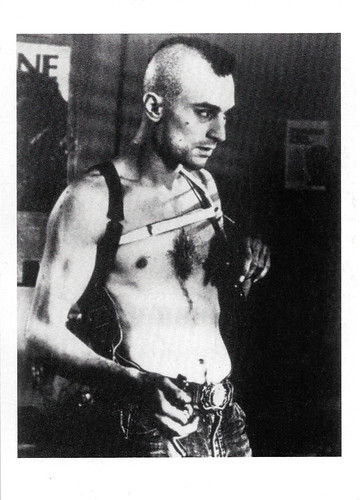
British postcard by Palm Pictures, no. C 20. Robert de Niro in Taxi Driver (Martin Scorsese, 1976).
Sources: Katharine Q. Seelye (New York Times), Rob Sharp (The Independent), Wikipedia (English and German) and .

East-German postcard by VEB Progress Film-Vertrieb, Berlin, no. 186/70. Photo: Steve Schapiro / Columbia. Barbra Streisand in Funny Girl (William Wyler, 1968).

British postcard by Star-Graphics, no. S 91. Photo: Steve Schapiro. Al Pacino and Marlon Brando in The Godfather (Francis Ford Coppola, 1972).

Italian postcard by Edizioni Beatrice D'Este, no. 20 162. Photo: Steve Schapiro. Robert De Niro in Taxi Driver (Martin Scorsese, 1976).

British postcard by Music & Movie Stars Ltd. Publishers, no. MMS 036. Photo: Steve Schapiro. Jodie Foster in Taxi Driver (Martin Scorsese, 1976).

American postcard by Coral-Lee, Rancho Cordova, CA, no. Personality #81, SC176971063. Photo: Steve Schapiro / Sygma. Burt Reynolds.
Photojournalist and real activist
Stephen Albert Schapiro was born during the Great Depression, in 1934 in Brooklyn and grew up in the Bronx. His parents were David Schapiro, a stationery store owner in Rockefeller Center and Esther (Sperling) Schapiro who worked at her husband's stationery store.
Steve discovered photography at Summer Camp at the age of nine and continued to take pictures as he grew up. One of his role models was the French photographer Henri Cartier-Bresson. He sought to emulate his style as he roamed the streets of New York. Schapiro attended Stuyvesant High School and Amherst College, from where he later transferred to Bard College. He graduated from there in 1955 with a degree in literature.
In 1960, Schapiro took lessons with W. Eugene Smith, an influential photographer during the Second World War. Smith taught him how to develop his own views of the world and photography. Schapiro even embedded with Smith for a time in his Manhattan loft. He learned how to make prints and picked up some tricks of the trade, like showing two points of interest in a portrait, which Smith told him would make the viewer’s eye go back and forth and thereby hold the viewer’s attention. Schapiro's work reflects the influence of his teacher.
In 1961 Schapiro began working as a freelance photographer. His photos were published in Life, Look, Vanity Fair, Sports Illustrated, Newsweek, Time and Paris Match. Schapiro photographed jazz pianist Bill Evans, artist Andy Warhol , writer Samuel Beckett, heavyweight boxer Muhammad Ali, actresses Barbra Streisand and Mia Farrow and musician David Bowie , among others.
The political, cultural and social changes of the 1960s in the United States were an inspiration for Schapiro. He accompanied Robert F. Kennedy during his presidential campaign. He captured key moments of the civil rights movement such as the March on Washington for Jobs and Freedom or the Selma to Montgomery marches. For Life, he documented the scene of the assassination of Martin Luther King in Memphis in 1968. Schapiro not only worked in photojournalism and documentation but also became a real activist. This is, for instance, visible in his way of documenting the hard lives of immigrant workers from Arkansas he dealt with in 1961.

American postcard by Classico San Francisco, no. 136-183. Photo: Steve Schapiro / The Ludlow Collection. Marlon Brando and Cat in The Godfather (Francis Ford Coppola, 1972).

British postcard by Star-Graphics, no. S 89. Photo: Steve Schapiro. Al Pacino in The Godfather (Francis Ford Coppola, 1972).

Belgian promotion card Taschenhen Gallery for the exhibition 'Taxi Driver - Unseen Photographs from Scorsese's Masterpiece'. Photo: Steve Schapiro. Robert de Niro in Taxi Driver (Martin Scorsese, 1976).

Canadian postcard by Canadian Postcard, no. A-5. Photo: Steve Schapiro. Robert de Niro in Taxi Driver (Martin Scorsese, 1976).

Vintage postcard. Photo: Steve Schapiro. Robert de Niro in Taxi Driver (Martin Scorsese, 1976).
Capturing key moments of modern American history
With the sharp decline in circulation figures for magazines such as Life and Look, the demand for high-quality photo essays fell from the end of the 1960s. Steve Schapiro moved to Los Angeles, where he photographed promotional material for film studios, artwork for record sleeves and portraits of well-known Hollywood stars, among other things. Having taken photos of Midnight Cowboy (John Schlesinger, 1969), among them also a famous one of Dustin Hoffman , he was hired as a photographer by Paramount Pictures.
He photographed on the set of the mafia epic The Godfather (1972) by Francis Ford Coppola with a cast including Marlon Brando , Al Pacino , James Caan and Robert Duvall. One of his photographs is of "Marlon Brando and the Cat". Rob Sharp in The Independent: "A man in his early fifties is dressed in black tie. He is lit from above, which throws his features into an intimidating scowl. The picture is completed – rather incongruously – by a young cat in his arms."
Schapiro was also present at the film set of Chinatown (1974) by Roman Polanski. His role involved being as unobtrusive as possible while the actors worked. As such, very little of what he produced was posed for. In 1974, he also shot the cover for the debut issue of People magazine: a portrait of Mia Farrow as Daisy Buchanan in The Great Gatsby (Jack Clayton, 1974).
Two years later, Schapiro was – by request of Robert De Niro – hired as a photographer on the set of Martin Scorsese's film Taxi Driver (1976). The chilling film situated in New York in the angry climate of the post-Vietnam era, became a milestone and DeNiro’s portrait of a trigger-happy psychopath with a mohawk is one of the greatest performances of the 1970s. As the special photographer on the set, Schapiro captured the film’s most intense and violent moments from behind the scenes.
During his career of six decades, Schapiro captured key moments of modern American history with his photos that also reflect his own social and human awareness. In 2022, he died from pancreatic cancer at his home in Chicago, at the age of 87. Schapiro was married three times. His first two marriages ended in divorce. He was survived by his wife Maura Smith, two sons, Theophilus Donoghue and Adam Schapiro; two daughters, Elle Harvey and Taylor Schapiro; and four grandchildren. Another son, Teddy Schapiro, died in 2014.

French postcard in the Collection Cinema Couleur by Editions La Malibran, Paris, no. MC 33, 1990. Photo: Steve Schapiro. Robert De Niro in Taxi Driver (Martin Scorsese, 1976).

British postcard by Memory Card, no. 530. Jodie Foster and Robert de Niro in Taxi Driver (Martin Scorsese, 1976).

British postcard by Memory Card, no. 531. Robert de Niro in Taxi Driver (Martin Scorsese, 1976).

British postcard by Memory Card, no. 532. Harvey Keitel and Robert de Niro in Taxi Driver (Martin Scorsese, 1976).

British postcard by Palm Pictures, no. C 20. Robert de Niro in Taxi Driver (Martin Scorsese, 1976).
Sources: Katharine Q. Seelye (New York Times), Rob Sharp (The Independent), Wikipedia (English and German) and .
Published on March 17, 2024 23:00
March 16, 2024
Patricia Ellis
Patricia Ellis (1915-1970) was an American film actress of the 1930s. Barely a teenager, she came to films in 1932, playing a variety of ingenues opposite such Warner Bros. contractees as James Cagney, Dick Powell, George Arliss, Paul Muni and Joe E. Brown. Most of her post-Warners roles were unremarkable, though she demonstrated that she could carry a picture when she starred in the innocuous Republic musical Rhythm in the Clouds (1937), and proved a worthy foil to Laurel and Hardy in Block-Heads (1938). Patricia Ellis retired from films in 1941 to marry a Kansas City business executive.
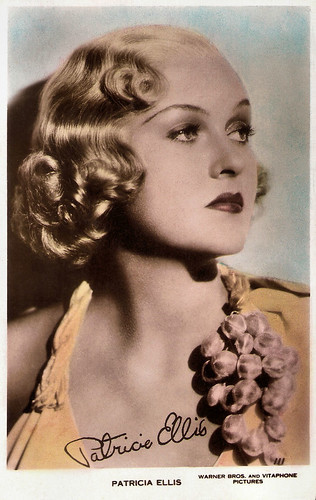
British postcard by Art Photo. Photo: Warner Bros / Vitaphone Pictures.
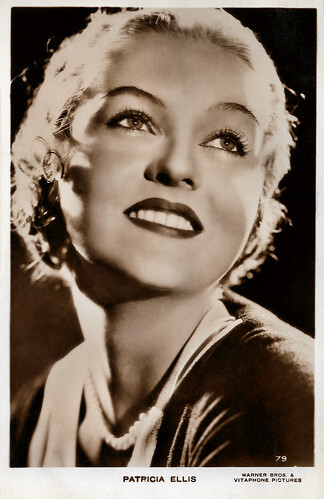
British Real Photograph postcard, no. 79. Photo: Warner Bros / Vitaphone Pictures.
The Queen of B pictures at Warner Brothers
Patricia Ellis was born Patricia Gene O'Brien in 1915 (sources differ about her age) in Birmingham, Michigan. Ellis was the oldest of four children born to Eugene Gladstone O'Brien, a Detroit insurance salesman, and Florence Calkins. Her parents divorced in 1929. She was later known as Patricia Leftwich after her step-father, Alexander Leftwich, an actor and New York producer of musical shows.
Her childhood activities included singing and dancing, and she learned French and German. A 1932 newspaper article said, "Since she was able to walk, Patricia has been familiar with the world of the theatre, accompanying her father constantly to rehearsals and performances."
Also in 1932, another newspaper reported, "She understudied all her father's leading women in the last few years, assisted him with lighting and costuming and knows stage production, too." Ellis attended Brantwood Hall School and Gardner School for Girls and began her stage career after leaving school. She took classes in studio facilities while pursuing her acting career.
Ellis appeared with Chamberlain Browns stock company. Given a film test, while appearing on stage in New York City, Ellis was put under contract by Warner Bros. In 1932, she had two small parts, both uncredited, in the crime dramas Three on a Match (Mervyn LeRoy, 1932) with Joan Blondell , Ann Dvorak and Bette Davis , and Central Park (John G. Adolfi, 1932), also starring Blondell. That same year, she was chosen as WAMPAS Baby Star, alongside 13 other girls considered to have potential such as Ginger Rogers and Mary Carlisle. Ellis was the youngest.
Her first credited role was in The King's Vacation (John G. Adolfi, 1933), starring George Arliss . After that film, her career took off, with her starring mostly in lower-budget B-movies but still working steadily. Ellis called herself "the Queen of B pictures at Warner Brothers".
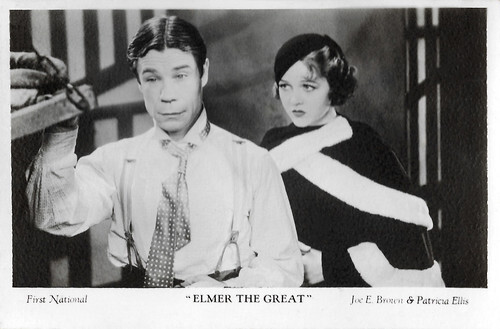
British postcard by Film Weekly, London. Photo: First national. Joe E. Brown and Patricia Ellis in Elmer, the Great (Mervyn LeRoy, 1933).
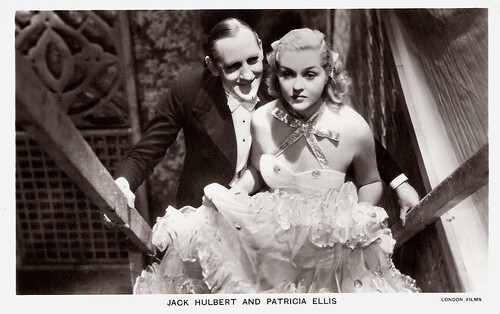
British postcard in the Film Partners Series, London, no. P 241. Photo: London Films. Jack Hulbert and Patricia Ellis in Paradise for Two/Gaiety Girls (Thornton Freeland, 1937).
Starring alongside some of Hollywood's biggest names
Patricia Ellis had roles in eight films in 1933, co-starring that year with James Cagney in Picture Snatcher (Lloyd Bacon, 1933), and in another seven in 1934. Within a few years, she had worked her way up from juvenile supporting roles to second leads.
She started 1935 off with A Night at the Ritz (William C. McGann, 1935), in which she had the lead female role, opposite William Gargan. She starred in seven films that year and another seven in 1936. Most of her roles were in comedy films, along with some mysteries and crime dramas, and by 1936 she was playing the female lead in almost all her films.
Starring alongside some of Hollywood's biggest names, including James Cagney , Ricardo Cortez , and Bela Lugosi , Ellis's career was at its peak by 1937. That year, she demonstrated that she could carry a picture when she starred in the innocuous Republic musical Rhythm in the Clouds (John H. Auer, 1937). In Great Britain, Patricia appeared in the comedy The Gaiety Girls/Paradise for two (Thornton Freeland, 1937) with Jack Hulbert and a young Googie Withers. She proved a worthy foil to Stan Laurel and Oliver Hardy in Block-Heads (John G. Blystone, 1938), and, against type, played a femme fatale in Fugitive at Large (Lewis D. Collins, 1939).
She starred in five films in 1937, then only three in 1938, and finally just two in 1939. After her work in film ended, Ellis ventured into music saying, "I was just getting into a rut in Hollywood. ... I want to start a new career -- singing." She made a soundie in 1941. A review in the trade publication Billboard commented: "Miss Ellis isn't bad on voice and excels (sic) on appearance. Men will pay attention to her." In 1941, she and Blue Barron and his Orchestra were headliners, along with Henny Youngman, at Hamid's Pier in Atlantic City, New Jersey and appeared on Broadway in 'Louisiana Purchase', a musical comedy.
Patricia Ellis retired in 1939 leaving Hollywood behind and in 1941, she married George Thomas O'Malley, future president of Protection Securities Systems in Kansas City, Missouri. She settled into private life, raising her family in Kansas City. The O'Malleys had one daughter. Ellis remained married to O'Malley for the remainder of her life, dying of cancer in 1970, in Kansas City. George O'Malley died thirty years later, in 2000.
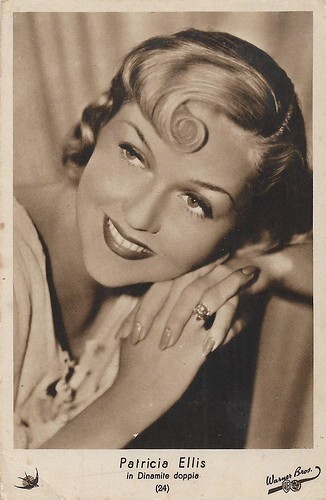
Italian postcard, series no. 24. Photo: Warner Bros., Italy. Patricia Ellis in The Picture Snatcher (Lloyd Bacon, 1933). The Italian release title was Dinamita doppia.
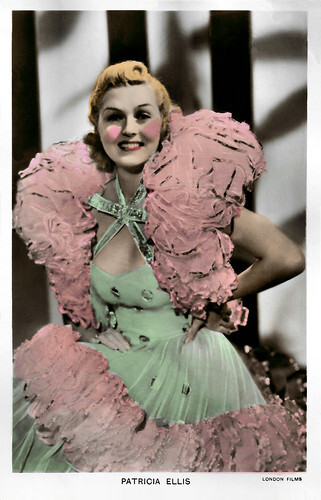
British postcard in the Colorgraph Series, London, no. C 294. Photo: London Films. Patricia Ellis in Paradise for Two/Gaiety Girls (Thornton Freeland, 1937). Caption: A Hand-coloured Real Photograph.
Sources: (IMDb), AllMovie, Wikipedia and .

British postcard by Art Photo. Photo: Warner Bros / Vitaphone Pictures.

British Real Photograph postcard, no. 79. Photo: Warner Bros / Vitaphone Pictures.
The Queen of B pictures at Warner Brothers
Patricia Ellis was born Patricia Gene O'Brien in 1915 (sources differ about her age) in Birmingham, Michigan. Ellis was the oldest of four children born to Eugene Gladstone O'Brien, a Detroit insurance salesman, and Florence Calkins. Her parents divorced in 1929. She was later known as Patricia Leftwich after her step-father, Alexander Leftwich, an actor and New York producer of musical shows.
Her childhood activities included singing and dancing, and she learned French and German. A 1932 newspaper article said, "Since she was able to walk, Patricia has been familiar with the world of the theatre, accompanying her father constantly to rehearsals and performances."
Also in 1932, another newspaper reported, "She understudied all her father's leading women in the last few years, assisted him with lighting and costuming and knows stage production, too." Ellis attended Brantwood Hall School and Gardner School for Girls and began her stage career after leaving school. She took classes in studio facilities while pursuing her acting career.
Ellis appeared with Chamberlain Browns stock company. Given a film test, while appearing on stage in New York City, Ellis was put under contract by Warner Bros. In 1932, she had two small parts, both uncredited, in the crime dramas Three on a Match (Mervyn LeRoy, 1932) with Joan Blondell , Ann Dvorak and Bette Davis , and Central Park (John G. Adolfi, 1932), also starring Blondell. That same year, she was chosen as WAMPAS Baby Star, alongside 13 other girls considered to have potential such as Ginger Rogers and Mary Carlisle. Ellis was the youngest.
Her first credited role was in The King's Vacation (John G. Adolfi, 1933), starring George Arliss . After that film, her career took off, with her starring mostly in lower-budget B-movies but still working steadily. Ellis called herself "the Queen of B pictures at Warner Brothers".

British postcard by Film Weekly, London. Photo: First national. Joe E. Brown and Patricia Ellis in Elmer, the Great (Mervyn LeRoy, 1933).

British postcard in the Film Partners Series, London, no. P 241. Photo: London Films. Jack Hulbert and Patricia Ellis in Paradise for Two/Gaiety Girls (Thornton Freeland, 1937).
Starring alongside some of Hollywood's biggest names
Patricia Ellis had roles in eight films in 1933, co-starring that year with James Cagney in Picture Snatcher (Lloyd Bacon, 1933), and in another seven in 1934. Within a few years, she had worked her way up from juvenile supporting roles to second leads.
She started 1935 off with A Night at the Ritz (William C. McGann, 1935), in which she had the lead female role, opposite William Gargan. She starred in seven films that year and another seven in 1936. Most of her roles were in comedy films, along with some mysteries and crime dramas, and by 1936 she was playing the female lead in almost all her films.
Starring alongside some of Hollywood's biggest names, including James Cagney , Ricardo Cortez , and Bela Lugosi , Ellis's career was at its peak by 1937. That year, she demonstrated that she could carry a picture when she starred in the innocuous Republic musical Rhythm in the Clouds (John H. Auer, 1937). In Great Britain, Patricia appeared in the comedy The Gaiety Girls/Paradise for two (Thornton Freeland, 1937) with Jack Hulbert and a young Googie Withers. She proved a worthy foil to Stan Laurel and Oliver Hardy in Block-Heads (John G. Blystone, 1938), and, against type, played a femme fatale in Fugitive at Large (Lewis D. Collins, 1939).
She starred in five films in 1937, then only three in 1938, and finally just two in 1939. After her work in film ended, Ellis ventured into music saying, "I was just getting into a rut in Hollywood. ... I want to start a new career -- singing." She made a soundie in 1941. A review in the trade publication Billboard commented: "Miss Ellis isn't bad on voice and excels (sic) on appearance. Men will pay attention to her." In 1941, she and Blue Barron and his Orchestra were headliners, along with Henny Youngman, at Hamid's Pier in Atlantic City, New Jersey and appeared on Broadway in 'Louisiana Purchase', a musical comedy.
Patricia Ellis retired in 1939 leaving Hollywood behind and in 1941, she married George Thomas O'Malley, future president of Protection Securities Systems in Kansas City, Missouri. She settled into private life, raising her family in Kansas City. The O'Malleys had one daughter. Ellis remained married to O'Malley for the remainder of her life, dying of cancer in 1970, in Kansas City. George O'Malley died thirty years later, in 2000.

Italian postcard, series no. 24. Photo: Warner Bros., Italy. Patricia Ellis in The Picture Snatcher (Lloyd Bacon, 1933). The Italian release title was Dinamita doppia.

British postcard in the Colorgraph Series, London, no. C 294. Photo: London Films. Patricia Ellis in Paradise for Two/Gaiety Girls (Thornton Freeland, 1937). Caption: A Hand-coloured Real Photograph.
Sources: (IMDb), AllMovie, Wikipedia and .
Published on March 16, 2024 23:00
March 15, 2024
Jack Oakie
American actor Jack Oakie (1903-1978) was one of the best wisecracking comedians during the golden age of Hollywood. The beefy, plump-faced comedian could steal a scene simply by looking at a girl’s legs.
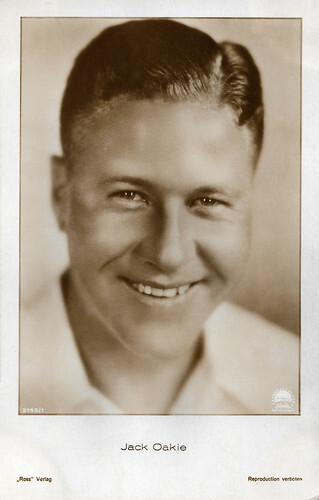
German postcard by Ross Verlag, no. 5145/1, 1930-1931. Photo: Paramount Pictures.
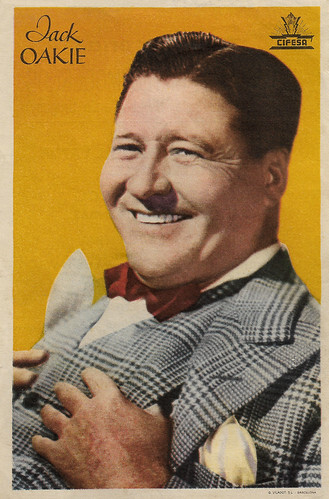
Spanish collector card by I.G. Viladot, Barcelona. Image: Cifesa.
From Broadway to Vaudeville to Hollywood
Jack Oakie was born Lewis Delaney Offield in 1903, in Sedalia, Missouri. His father was a grain dealer, and his mother was a psychology teacher. When he was 5, the Offield family moved to Muskogee, Oklahoma, the source of his "Oakie" nickname.
Oakie spent part of his boyhood in Kansas City with his grandmother and attended Woodland School. He sold papers for the Kansas City Star: He later recalled that he made good money selling “extras” on the night Woodrow Wilson was reelected as president in 1916. Oakie worked as a runner on Wall Street and narrowly escaped being killed in the Wall Street bombing of 16 September 1920.
While in New York, he also started appearing in amateur theatre as a mimic and a comedian. In 1923 Oakie landed a job as a chorus boy in George M. Cohan’s 'Little Nelly Kelly' on Broadway.
He went from Broadway to vaudeville, with Lulu McConnell as his partner. From there he found employment in several comedies, as well as musicals throughout the mid to late 1920s These included 'Sharlee' (1923), the revues 'Innocent Eyes' (1924) and 'Artists and Models' (1925), and the musical 'Peggy-Ann' (1926).
In 1927 Oakie went to Hollywood, and he was cast as a comedian in his first silent film, Finders Keepers (Wesley Ruggles, 1927) starring Laura La Plante . He also appeared in the silent films The Fleet's In (Malcolm St. Clair, 1928) starring Clara Bow and the Western Sin Town (J. Gordon Cooper, William K. Howard, 1929).
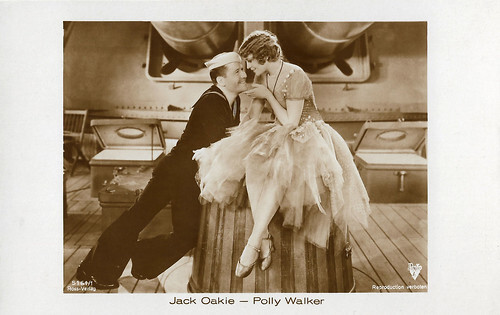
German postcard by Ross Verlag, no. 5161/1, 1930-1931. Photo: Radio. Jack Oakie and Polly Walker in Hit the Deck (Luther Reed, 1929).
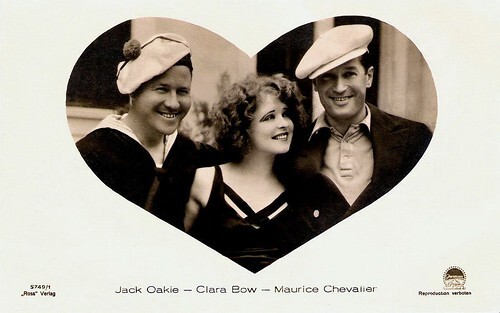
German postcard by Ross Verlag, no. 5749/1, 1930-1931. Photo: Paramount. Jack Oakie, Clara Bow and Maurice Chevalier in Paramount on Parade (Dorothy Arzner a.o., 1930).
The World's Oldest Freshman
With the advent of sound, Jack Oakie signed a contract with Paramount. His first talkie was The Dummy (Robert Milton, Louis J. Gasnier, 1929) starring Ruth Chatterton and Fredric March .
Jack went on to support Wallace Beery in Chinatown Nights (William A. Wellman, 1929), Dorothy Mackaill in Hard to Get (William Beaudine, 1929) and Betty Compson in Street Girl (Wesley Ruggles, 1929).
Settling in, he never returned to the Broadway stage. With Nancy Carroll , he played in the musical Sweetie (Frank Tuttle, 1929). He appeared in many of the big musicals of the day with Bing Crosby , Maurice Chevalier and Alice Faye. He was a brush salesman turned Olympic scout in the hilarious screwball farce Million Dollar Legs (Edward F. Cline, 1932) and an unwilling gangster in Dancers in the Dark (David Burton, 1932) opposite Miriam Hopkins .
He played Tweedledum to Roscoe Karns' Tweedledee in the all-star version of Alice in Wonderland (Norman Z. McLeod, Hugh Harman, Rudolf Ising, 1933). In Too Much Harmony (A. Edward Sutherland, 1933), the part of Oakie's on-screen mother was played by his real mother, Mary Evelyn Offield.
During the 1930s, he was known as "The World's Oldest Freshman", as a result of appearing in such collegiate films as The Wild Party (Dorothy Arzner, 1929), Sweetie (Frank Tuttle, 1929), Touchdown! (Norman Z. McLeod, 1931), College Humor (Wesley Ruggles, 1933), College Rhythm (Norman Taurog, 1934) and Collegiate (Ralph Murphy, 1935). Oakie's contract with Paramount ended in 1934 and he continued as a freelancing agent. Not being limited by a film studio contract, Oakie branched into radio and had his radio show between 1936 and 1938.
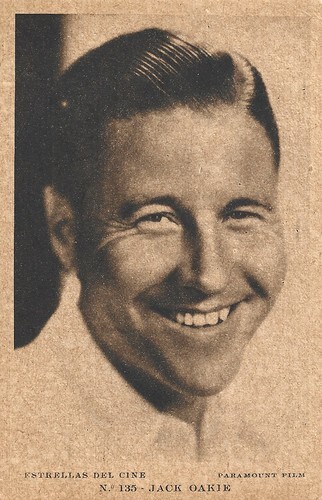
Spanish postcard in the Series Estrellas del Cine, no. 135. Photo: Paramount Film.
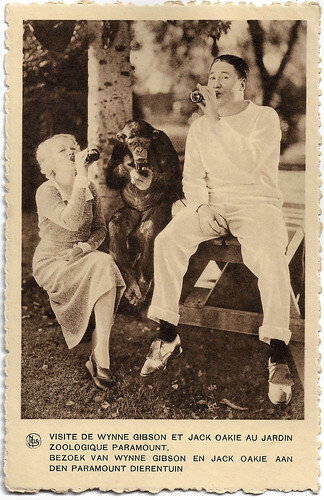
Belgian postcard by Nels for Chocolat Martougin. Photo: Photo Actualit, Brux. Caption: Wynne Gibson and Jack Oakie visit the Paramount Zoo.
Napolini, Il Duce of Bacteria
Jack Oakie's role as Napolini, Il Duce of Bacteria in Chaplin's The Great Dictator (Charles Chaplin, 1940), was a brilliant and very thinly disguised slam at Mussolini. It earned Oakie his only Oscar nomination, for Best Supporting Actor. It was the highlight of his career.
He followed it with supporting parts in bright, silly and feather-light films such as Tin Pan Alley (Walter Lang, 1940), Hello, Frisco, Hello (H. Bruce Humberstone, 1943), and Sweet and Low-Down (Archie Mayo, 1944), with Linda Darnell and Benny Goodman.
Jack's last high-profile films were the Betty Grable musical When My Baby Smiles at Me (Walter Lang, 1948) and the fast-moving gangster film Thieves Highway (Jules Dassin, 1949). In his later years, Oakie made some television appearances in episodes of such television shows as The Real McCoys (1963), Daniel Boone (1966), and Bonanza (1966).
He also turned up in films from time to time, including a cameo in Around the World in 80 Days (Michael Anderson, John Farrow, 1956) and roles in The Wonderful Country (Robert Parrish, 1958), Debbie Reynolds' The Rat Race (Robert Mulligan, 1960) and the comedy Lover Come Back (Delbert Mann, 1961) with Doris Day and Rock Hudson . It was his final film.
Jack Oakie lived in baronial style on a ten-acre estate in Northridge, at the northern end of the San Fernando Valley. His first marriage (1936-1945) was to Venita Varden, who perished in the 1948 air crash of United Airlines Flight 624 at Mount Carmel, Pennsylvania. Oakie's second marriage was to actress Victoria Horne in 1950. They moved to an estate in Northridge and lived there until his death. He died in 1978, at the age of seventy-four. Jack Oakie was married twice. His remains were interred at Forest Lawn Memorial Park, in the Los Angeles area.
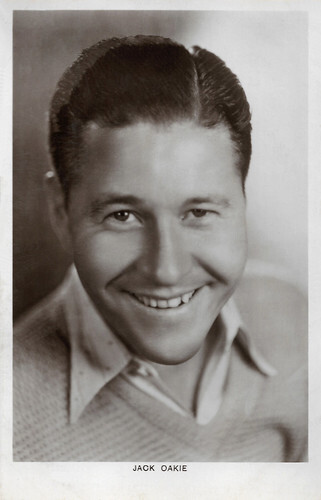
British postcard in the Picturegoer Series, London, no, 463.
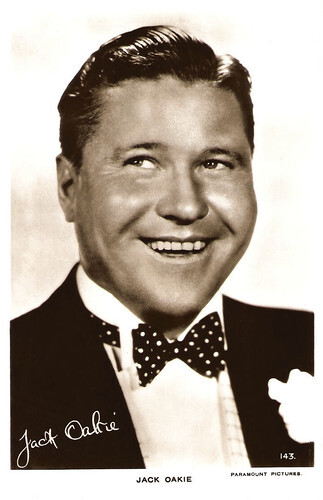
British Real Photograph postcard, no. 143. Photo: Paramount Pictures.
Sources: Eve Golden (Classic Images), Arthur F. McClure (Missouri Encyclopedia), Wikipedia and .

German postcard by Ross Verlag, no. 5145/1, 1930-1931. Photo: Paramount Pictures.

Spanish collector card by I.G. Viladot, Barcelona. Image: Cifesa.
From Broadway to Vaudeville to Hollywood
Jack Oakie was born Lewis Delaney Offield in 1903, in Sedalia, Missouri. His father was a grain dealer, and his mother was a psychology teacher. When he was 5, the Offield family moved to Muskogee, Oklahoma, the source of his "Oakie" nickname.
Oakie spent part of his boyhood in Kansas City with his grandmother and attended Woodland School. He sold papers for the Kansas City Star: He later recalled that he made good money selling “extras” on the night Woodrow Wilson was reelected as president in 1916. Oakie worked as a runner on Wall Street and narrowly escaped being killed in the Wall Street bombing of 16 September 1920.
While in New York, he also started appearing in amateur theatre as a mimic and a comedian. In 1923 Oakie landed a job as a chorus boy in George M. Cohan’s 'Little Nelly Kelly' on Broadway.
He went from Broadway to vaudeville, with Lulu McConnell as his partner. From there he found employment in several comedies, as well as musicals throughout the mid to late 1920s These included 'Sharlee' (1923), the revues 'Innocent Eyes' (1924) and 'Artists and Models' (1925), and the musical 'Peggy-Ann' (1926).
In 1927 Oakie went to Hollywood, and he was cast as a comedian in his first silent film, Finders Keepers (Wesley Ruggles, 1927) starring Laura La Plante . He also appeared in the silent films The Fleet's In (Malcolm St. Clair, 1928) starring Clara Bow and the Western Sin Town (J. Gordon Cooper, William K. Howard, 1929).

German postcard by Ross Verlag, no. 5161/1, 1930-1931. Photo: Radio. Jack Oakie and Polly Walker in Hit the Deck (Luther Reed, 1929).

German postcard by Ross Verlag, no. 5749/1, 1930-1931. Photo: Paramount. Jack Oakie, Clara Bow and Maurice Chevalier in Paramount on Parade (Dorothy Arzner a.o., 1930).
The World's Oldest Freshman
With the advent of sound, Jack Oakie signed a contract with Paramount. His first talkie was The Dummy (Robert Milton, Louis J. Gasnier, 1929) starring Ruth Chatterton and Fredric March .
Jack went on to support Wallace Beery in Chinatown Nights (William A. Wellman, 1929), Dorothy Mackaill in Hard to Get (William Beaudine, 1929) and Betty Compson in Street Girl (Wesley Ruggles, 1929).
Settling in, he never returned to the Broadway stage. With Nancy Carroll , he played in the musical Sweetie (Frank Tuttle, 1929). He appeared in many of the big musicals of the day with Bing Crosby , Maurice Chevalier and Alice Faye. He was a brush salesman turned Olympic scout in the hilarious screwball farce Million Dollar Legs (Edward F. Cline, 1932) and an unwilling gangster in Dancers in the Dark (David Burton, 1932) opposite Miriam Hopkins .
He played Tweedledum to Roscoe Karns' Tweedledee in the all-star version of Alice in Wonderland (Norman Z. McLeod, Hugh Harman, Rudolf Ising, 1933). In Too Much Harmony (A. Edward Sutherland, 1933), the part of Oakie's on-screen mother was played by his real mother, Mary Evelyn Offield.
During the 1930s, he was known as "The World's Oldest Freshman", as a result of appearing in such collegiate films as The Wild Party (Dorothy Arzner, 1929), Sweetie (Frank Tuttle, 1929), Touchdown! (Norman Z. McLeod, 1931), College Humor (Wesley Ruggles, 1933), College Rhythm (Norman Taurog, 1934) and Collegiate (Ralph Murphy, 1935). Oakie's contract with Paramount ended in 1934 and he continued as a freelancing agent. Not being limited by a film studio contract, Oakie branched into radio and had his radio show between 1936 and 1938.

Spanish postcard in the Series Estrellas del Cine, no. 135. Photo: Paramount Film.

Belgian postcard by Nels for Chocolat Martougin. Photo: Photo Actualit, Brux. Caption: Wynne Gibson and Jack Oakie visit the Paramount Zoo.
Napolini, Il Duce of Bacteria
Jack Oakie's role as Napolini, Il Duce of Bacteria in Chaplin's The Great Dictator (Charles Chaplin, 1940), was a brilliant and very thinly disguised slam at Mussolini. It earned Oakie his only Oscar nomination, for Best Supporting Actor. It was the highlight of his career.
He followed it with supporting parts in bright, silly and feather-light films such as Tin Pan Alley (Walter Lang, 1940), Hello, Frisco, Hello (H. Bruce Humberstone, 1943), and Sweet and Low-Down (Archie Mayo, 1944), with Linda Darnell and Benny Goodman.
Jack's last high-profile films were the Betty Grable musical When My Baby Smiles at Me (Walter Lang, 1948) and the fast-moving gangster film Thieves Highway (Jules Dassin, 1949). In his later years, Oakie made some television appearances in episodes of such television shows as The Real McCoys (1963), Daniel Boone (1966), and Bonanza (1966).
He also turned up in films from time to time, including a cameo in Around the World in 80 Days (Michael Anderson, John Farrow, 1956) and roles in The Wonderful Country (Robert Parrish, 1958), Debbie Reynolds' The Rat Race (Robert Mulligan, 1960) and the comedy Lover Come Back (Delbert Mann, 1961) with Doris Day and Rock Hudson . It was his final film.
Jack Oakie lived in baronial style on a ten-acre estate in Northridge, at the northern end of the San Fernando Valley. His first marriage (1936-1945) was to Venita Varden, who perished in the 1948 air crash of United Airlines Flight 624 at Mount Carmel, Pennsylvania. Oakie's second marriage was to actress Victoria Horne in 1950. They moved to an estate in Northridge and lived there until his death. He died in 1978, at the age of seventy-four. Jack Oakie was married twice. His remains were interred at Forest Lawn Memorial Park, in the Los Angeles area.

British postcard in the Picturegoer Series, London, no, 463.

British Real Photograph postcard, no. 143. Photo: Paramount Pictures.
Sources: Eve Golden (Classic Images), Arthur F. McClure (Missouri Encyclopedia), Wikipedia and .
Published on March 15, 2024 23:00
March 13, 2024
The Kiss Before the Mirror (1933)
The American mystery thriller The Kiss Before the Mirror (1933) was adapted from the 1932 play by Ladislas Fodor and directed by James Whale. The four stars of the film were Nancy Carroll, Frank Morgan, Paul Lukas, and Gloria Stuart.

British postcard in the Film Weekly series. Photo: Universal. Nancy Carroll and Frank Morgan in The Kiss Before the Mirror (James Whale, 1933).
A similarity to the events described in court
Noted attorney Paul Held (Frank Morgan) is defending his friend, Walter Bernsdorf ( Paul Lukas ), who has been charged with the murder of his wife Lucy ( Gloria Stuart ) in Vienna. By Walter's account, Lucy was unfaithful to him during their marriage.
After a court hearing, Paul returns home to his wife, Maria ( Nancy Carroll ), and watches her as she applies makeup in front of her vanity mirror. Paul recognizes a similarity to the events Walter had described in court and notices that his wife appears to pay special attention to her makeup for reasons unconnected with her love for him. Paul kisses Maria, and she angrily repulses him, claiming he has ruined her makeup; then she casually goes out.
Like Walter before him, Paul follows his wife through the streets of Vienna and observes her meeting with a male lover (Donald Cook). This enrages Paul, and he fantasizes about murdering Maria. He also becomes obsessed with vindicating Walter by proving that his love for his wife made him crazed with jealousy when he saw her with another man.
Maria becomes uneasy because the trial hits too close to home, but she continues to visit her lover. On the final day of deliberations in Walter's trial, Paul insists that Maria be present. He makes an impassioned closing appeal in which he claims that "the more a man loves and the more he is deceived, the greater his desire for revenge" and which he concludes by revealing a gun and pointing it at Maria in the audience. She screams in horror and loses consciousness, after which Paul finishes his speech.
While the jury deliberates, Paul meets Maria in his office, where she reacts in terror. She insists she still loves him despite her affair. Walter is ultimately acquitted and warns Paul against killing Maria, which he says he will regret. Paul heeds his advice and asks Maria to leave the courthouse. Upon returning home, Paul angrily smashes Maria's vanity mirror. Maria appears behind him, and the two embrace.

British postcard in the Film Weekly series. Photo: Universal. Frank Morgan, Paul Lukas and Nancy Carroll in The Kiss Before the Mirror (James Whale, 1933).

British postcard in the Film Weekly series. Photo: Universal. Nancy Carroll , Jean Dixon and Frank Morgan in The Kiss Before the Mirror (James Whale, 1933).
The film is chock full of surprises
English film director James Whale is best remembered for his four classic horror films: Frankenstein (1931), The Old Dark House (1932), The Invisible Man (1933) and Bride of Frankenstein (1935). He also directed interesting films in other genres, including screwball comedies and musicals. The Kiss Before the Mirror (1933) is a superior mystery thriller.
In 1933, Pare Lorentz wrote in Vanity Fair: "Director Whale was fortunate in having Frank Morgan and Paul Lukas as his leading men, and Karl Freund, the best man in the business, as cameraman for A Kiss Before the Mirror. I don't know how they happened to slip Nancy Carroll into the show, but we'll dismiss that. There is a pictorial quality about the opening scenes, and a maturity in the dialogue which makes a better part of the picture seem true and important."
"The film is chock full of surprises for the viewer, almost as much in the twenty-first century as it was in 1933", writes Bruce Eder at AllMovie. "The opening minutes seem to be shaping up as a horror film, complete with the image of a stalker moving toward a house where an illicit couple (Walter Pidgeon, Gloria Stuart) are having a rendezvous - but it also almost threatens to become a musical, as the couple are each heard humming and vamping to tango as they prepare to meet, in what is just short of an erotic pre-coital ballet. And then, just as it reaches a new height of implied eroticism, it becomes something entirely different, as murderous rage explodes before the camera and the audience.
Director James Whale carries us across this rapidly shifting cinematic landscape - much of it decorated in a beautifully understated art deco style (courtesy of art director Charles D. Hall) - in seemingly effortless fashion in just the first few minutes of The Kiss Before The Mirror, and then it gets really interesting - we're introduced to an array of deceptively complex characters, of whom the most interesting, other than the pairing of Frank Morgan and Nancy Carroll as the husband-and-wife headed into dangerous straits, is the lawyer played by Jean Dixon. Amid some amazing acting and character flourishes by the two leads, and quietly flamboyant support from Charles Grapewin as a dipsomaniac law clerk, Dixon's lady lawyer must constantly differentiate between her perceptions as a lawyer and a woman; when asked which she is, she remarks that by day she is a lawyer, and by night . . . 'you'd be surprised'."
The film was the subject of a remake by director James Whale himself. Five years later, he directed the same story under the title Wives Under Suspicion (James Whale, 1938), with a different cast including Warren William and Gail Patrick and on a much smaller budget. He made a few noticeable concessions for the more militant censors of 1938. However, Hal Erickson at AllMovie liked the result: "Indeed, Wives is a "B" picture, but one wouldn't know it from the care and attention that Whale gives it. An expressionistic opening lets the viewer know that Whale is going to do his best with the budget at hand, and he keeps the film visually interesting throughout."
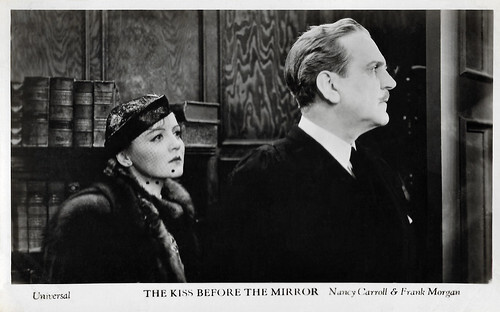
British postcard in the Film Weekly series. Photo: Universal. Nancy Carroll and Frank Morgan in The Kiss Before the Mirror (James Whale, 1933).
Sources: Pare Lorentz (Vanity Fair), Bruce Eder (AllMovie), Mark Deming (AllMovie), Hal Erickson (AllMovie), AFI Catalog, Wikipedia and IMDb.

British postcard in the Film Weekly series. Photo: Universal. Nancy Carroll and Frank Morgan in The Kiss Before the Mirror (James Whale, 1933).
A similarity to the events described in court
Noted attorney Paul Held (Frank Morgan) is defending his friend, Walter Bernsdorf ( Paul Lukas ), who has been charged with the murder of his wife Lucy ( Gloria Stuart ) in Vienna. By Walter's account, Lucy was unfaithful to him during their marriage.
After a court hearing, Paul returns home to his wife, Maria ( Nancy Carroll ), and watches her as she applies makeup in front of her vanity mirror. Paul recognizes a similarity to the events Walter had described in court and notices that his wife appears to pay special attention to her makeup for reasons unconnected with her love for him. Paul kisses Maria, and she angrily repulses him, claiming he has ruined her makeup; then she casually goes out.
Like Walter before him, Paul follows his wife through the streets of Vienna and observes her meeting with a male lover (Donald Cook). This enrages Paul, and he fantasizes about murdering Maria. He also becomes obsessed with vindicating Walter by proving that his love for his wife made him crazed with jealousy when he saw her with another man.
Maria becomes uneasy because the trial hits too close to home, but she continues to visit her lover. On the final day of deliberations in Walter's trial, Paul insists that Maria be present. He makes an impassioned closing appeal in which he claims that "the more a man loves and the more he is deceived, the greater his desire for revenge" and which he concludes by revealing a gun and pointing it at Maria in the audience. She screams in horror and loses consciousness, after which Paul finishes his speech.
While the jury deliberates, Paul meets Maria in his office, where she reacts in terror. She insists she still loves him despite her affair. Walter is ultimately acquitted and warns Paul against killing Maria, which he says he will regret. Paul heeds his advice and asks Maria to leave the courthouse. Upon returning home, Paul angrily smashes Maria's vanity mirror. Maria appears behind him, and the two embrace.

British postcard in the Film Weekly series. Photo: Universal. Frank Morgan, Paul Lukas and Nancy Carroll in The Kiss Before the Mirror (James Whale, 1933).

British postcard in the Film Weekly series. Photo: Universal. Nancy Carroll , Jean Dixon and Frank Morgan in The Kiss Before the Mirror (James Whale, 1933).
The film is chock full of surprises
English film director James Whale is best remembered for his four classic horror films: Frankenstein (1931), The Old Dark House (1932), The Invisible Man (1933) and Bride of Frankenstein (1935). He also directed interesting films in other genres, including screwball comedies and musicals. The Kiss Before the Mirror (1933) is a superior mystery thriller.
In 1933, Pare Lorentz wrote in Vanity Fair: "Director Whale was fortunate in having Frank Morgan and Paul Lukas as his leading men, and Karl Freund, the best man in the business, as cameraman for A Kiss Before the Mirror. I don't know how they happened to slip Nancy Carroll into the show, but we'll dismiss that. There is a pictorial quality about the opening scenes, and a maturity in the dialogue which makes a better part of the picture seem true and important."
"The film is chock full of surprises for the viewer, almost as much in the twenty-first century as it was in 1933", writes Bruce Eder at AllMovie. "The opening minutes seem to be shaping up as a horror film, complete with the image of a stalker moving toward a house where an illicit couple (Walter Pidgeon, Gloria Stuart) are having a rendezvous - but it also almost threatens to become a musical, as the couple are each heard humming and vamping to tango as they prepare to meet, in what is just short of an erotic pre-coital ballet. And then, just as it reaches a new height of implied eroticism, it becomes something entirely different, as murderous rage explodes before the camera and the audience.
Director James Whale carries us across this rapidly shifting cinematic landscape - much of it decorated in a beautifully understated art deco style (courtesy of art director Charles D. Hall) - in seemingly effortless fashion in just the first few minutes of The Kiss Before The Mirror, and then it gets really interesting - we're introduced to an array of deceptively complex characters, of whom the most interesting, other than the pairing of Frank Morgan and Nancy Carroll as the husband-and-wife headed into dangerous straits, is the lawyer played by Jean Dixon. Amid some amazing acting and character flourishes by the two leads, and quietly flamboyant support from Charles Grapewin as a dipsomaniac law clerk, Dixon's lady lawyer must constantly differentiate between her perceptions as a lawyer and a woman; when asked which she is, she remarks that by day she is a lawyer, and by night . . . 'you'd be surprised'."
The film was the subject of a remake by director James Whale himself. Five years later, he directed the same story under the title Wives Under Suspicion (James Whale, 1938), with a different cast including Warren William and Gail Patrick and on a much smaller budget. He made a few noticeable concessions for the more militant censors of 1938. However, Hal Erickson at AllMovie liked the result: "Indeed, Wives is a "B" picture, but one wouldn't know it from the care and attention that Whale gives it. An expressionistic opening lets the viewer know that Whale is going to do his best with the budget at hand, and he keeps the film visually interesting throughout."

British postcard in the Film Weekly series. Photo: Universal. Nancy Carroll and Frank Morgan in The Kiss Before the Mirror (James Whale, 1933).
Sources: Pare Lorentz (Vanity Fair), Bruce Eder (AllMovie), Mark Deming (AllMovie), Hal Erickson (AllMovie), AFI Catalog, Wikipedia and IMDb.
Published on March 13, 2024 23:00
March 12, 2024
Toni van Eyck
German actress Toni van Eyck (1910-1988) became a star playing a rape victim in the Aufklärungsfilm Gefahren der Liebe/Hazards of Love (1931). Despite this film's success, she stayed primarily a stage actress.
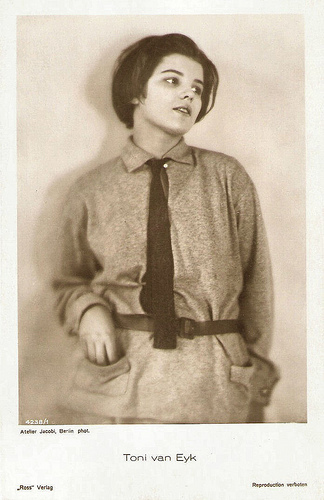
German postcard by Ross Verlag, no. 4238/1, 1929-1930. Photo: Atelier Jacobi, Berlin.
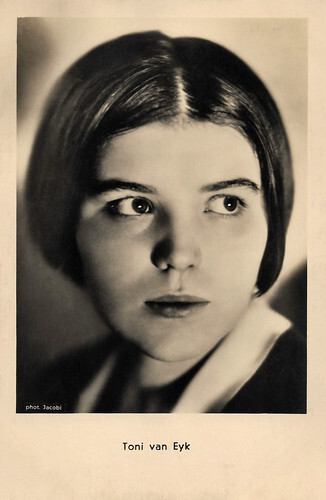
Austrian postcard by Iris Verlag, no. 6667. Photo: Jacobi.
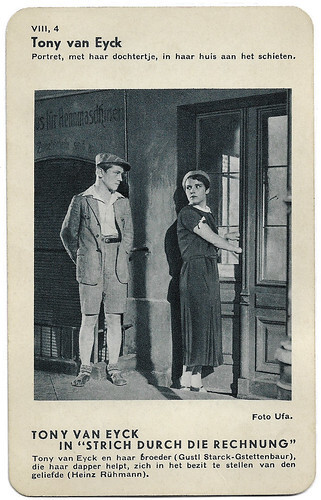
Dutch quartet play card, no. VIII, 4. Photo: Ufa. Toni van Eyck and Gustl Stark-Gstettenbaur in Strich durch die Rechnung/The Upset Plan (Alfred Zeisler, 1932).
A woman branded
Toni (also Tony) van Eyck (van Eyk) was born Gertrud Johanna Antonie Eick in 1910 in Koblenz, Germany.
She took acting lessons at the Max-Reinhardt-Seminar in Wien (Vienna) and at the Otto-Falkenberg-Schule in München (Munich). At the age of 15, she already played at various Berlin stages and convinced the critics with her performances.
She was discovered for the film in 1928 and appeared in the silent short Ins Blaue hinein/Into the Blue (Eugen Schüfftan, 1929) with Theo Lingen .
After a few more silent films, she became known with her leading role in the early Aufklärungsfilm (education film) Gefahren der Liebe/A Woman Branded (Eugen Thiele, 1931) opposite Hans Stüwe . She played a rape victim, who finally becomes a murderess.
In the following years, she appeared in such films as Kitty schwindelt sich ins Glück/Kitty is Giddy to Happiness (Herbert Juttke, 1932), Strich durch die Rechnung/Spoiling the Game (Alfred Zeisler, 1932) costarring with Heinz Rühmann , Was wissen denn Männer/What Do Men know (Gerhard Lamprecht, 1933), and Herthas Erwachen/Hertha's Awakening (Gerhard Lamprecht, 1933) opposite Hans Brausewetter .
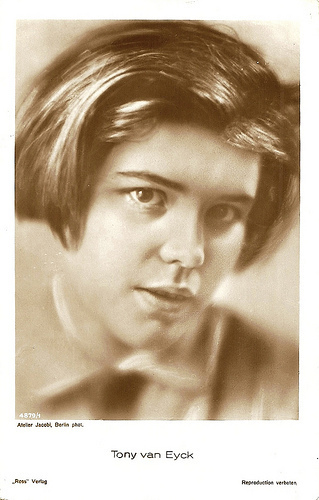
German postcard by Ross Verlag, no. 4879/1, 1929-1930. Photo: Atelier Jacobi, Berlin.
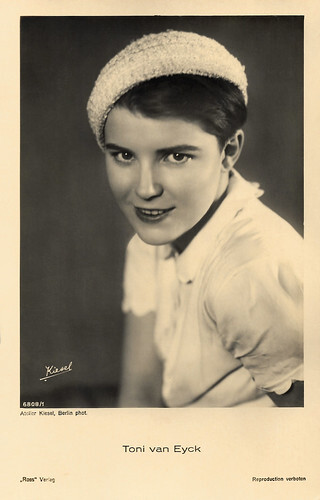
German postcard by Ross Verlag, no. 6809/1, 1931-1932. Photo: Atelier Kiesel, Berlin.
Appeal from the ether
Despite these successful roles in the early 1930s, Toni van Eyck would stay a theatre actress primarily. From 1938 to 1942 she was part of the ensemble of the famous Burgtheater in Vienna.
After the war, she acted at the Salzburger Landestheater (Salzburg State Theater).
In 1950 she made her last film. She played a small part in the crime drama Ruf aus dem Äther/Appeal from the Ether (Georg C. Klaren, Georg Wilhelm Pabst, 1951) starring Oskar Werner .
Later she worked as a playwright for stage and radio. In 1955 she published her novel, 'Ein Mann namens Miller' (A Man Named Miller). She also continued to appear on stage in guest appearances for a long time.
Toni van Eyck died in 1988.
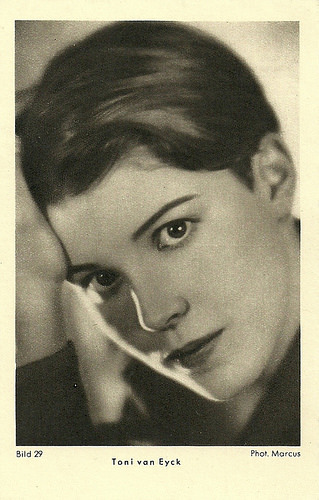
German postcard by Margarinewerk Gebr. Fauser GmbH. Eidelstadt, Holstein. 'Die trustfreie Eidelsan', no. 29. Photo Marcus.
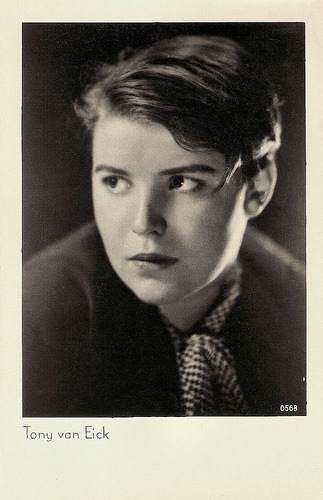
German postcard by Harlip, Berlin, no. 0568.
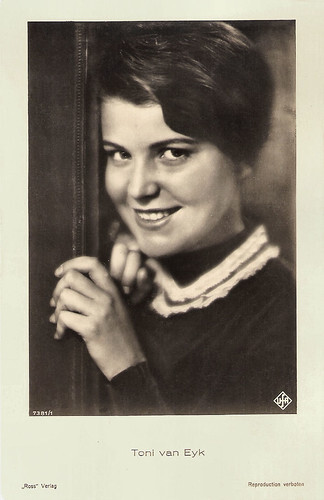
German postcard by Ross Verlag, no. 7381/1, 1932-1933. Photo: Ufa.
Sources: Thomas Staedeli (Cyranos), Wikipedia (German), and .

German postcard by Ross Verlag, no. 4238/1, 1929-1930. Photo: Atelier Jacobi, Berlin.

Austrian postcard by Iris Verlag, no. 6667. Photo: Jacobi.

Dutch quartet play card, no. VIII, 4. Photo: Ufa. Toni van Eyck and Gustl Stark-Gstettenbaur in Strich durch die Rechnung/The Upset Plan (Alfred Zeisler, 1932).
A woman branded
Toni (also Tony) van Eyck (van Eyk) was born Gertrud Johanna Antonie Eick in 1910 in Koblenz, Germany.
She took acting lessons at the Max-Reinhardt-Seminar in Wien (Vienna) and at the Otto-Falkenberg-Schule in München (Munich). At the age of 15, she already played at various Berlin stages and convinced the critics with her performances.
She was discovered for the film in 1928 and appeared in the silent short Ins Blaue hinein/Into the Blue (Eugen Schüfftan, 1929) with Theo Lingen .
After a few more silent films, she became known with her leading role in the early Aufklärungsfilm (education film) Gefahren der Liebe/A Woman Branded (Eugen Thiele, 1931) opposite Hans Stüwe . She played a rape victim, who finally becomes a murderess.
In the following years, she appeared in such films as Kitty schwindelt sich ins Glück/Kitty is Giddy to Happiness (Herbert Juttke, 1932), Strich durch die Rechnung/Spoiling the Game (Alfred Zeisler, 1932) costarring with Heinz Rühmann , Was wissen denn Männer/What Do Men know (Gerhard Lamprecht, 1933), and Herthas Erwachen/Hertha's Awakening (Gerhard Lamprecht, 1933) opposite Hans Brausewetter .

German postcard by Ross Verlag, no. 4879/1, 1929-1930. Photo: Atelier Jacobi, Berlin.

German postcard by Ross Verlag, no. 6809/1, 1931-1932. Photo: Atelier Kiesel, Berlin.
Appeal from the ether
Despite these successful roles in the early 1930s, Toni van Eyck would stay a theatre actress primarily. From 1938 to 1942 she was part of the ensemble of the famous Burgtheater in Vienna.
After the war, she acted at the Salzburger Landestheater (Salzburg State Theater).
In 1950 she made her last film. She played a small part in the crime drama Ruf aus dem Äther/Appeal from the Ether (Georg C. Klaren, Georg Wilhelm Pabst, 1951) starring Oskar Werner .
Later she worked as a playwright for stage and radio. In 1955 she published her novel, 'Ein Mann namens Miller' (A Man Named Miller). She also continued to appear on stage in guest appearances for a long time.
Toni van Eyck died in 1988.

German postcard by Margarinewerk Gebr. Fauser GmbH. Eidelstadt, Holstein. 'Die trustfreie Eidelsan', no. 29. Photo Marcus.

German postcard by Harlip, Berlin, no. 0568.

German postcard by Ross Verlag, no. 7381/1, 1932-1933. Photo: Ufa.
Sources: Thomas Staedeli (Cyranos), Wikipedia (German), and .
Published on March 12, 2024 23:00
March 11, 2024
Dorothy Malone
American actress Dorothy Malone (1925–2018) was a sultry, dreamy-eyed beauty. She started in Frank Sinatra musicals during the 1940s. She won a Best Supporting Actress Oscar for her sultry role in Written on the Wind (1956). Best known by the public for her starring role as Constance MacKenzie on Peyton Place (1964-1968). Her final role was as Sharon Stone's friend in Basic Instinct (1992).
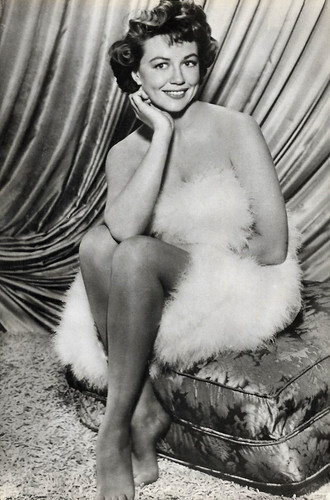
Spanish postcard by Edic. Raker, Barcelona, no. 247/6017.

French postcard by Editions P.I., Paris, no. 832, offered by Les Carbones Korès 'Carboplane'. Photo: Browning Studio H.P.S.
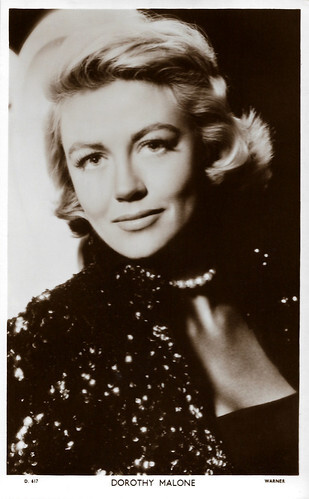
British postcard in the Picturegoer Series, London, no. D. 617. Photo: Warner.
A seductive book clerk
Dorothy Eloise Maloney was born in Chicago, Illinois, in 1925. She was one of five children born to an accountant father. Two older sisters died of polio. A younger brother later was killed by lightning while on a Dallas golf course. When she was a child, her family moved to Dallas, Texas. Attending Ursuline Convent and Highland Park High School, Dorothy was the 'School Favorite' and won several awards for swimming and horseback riding.
She modelled for Neiman Marcus. Following graduation, she studied at Southern Methodist University with the intent of becoming a nurse, but a role in the college play 'Starbound' happened to catch the eye of an RKO talent scout and she was offered a Hollywood contract.
At age 18, Dorothy Maloney made her film debut in Gildersleeve on Broadway (Gordon Douglas, 1943). The lovely brunette continued as an RKO starlet in the Frank Sinatra musicals Higher and Higher (Tim Whelan, 1943) and Step Lively (Tim Whelan, 1944), and a couple of the Falcon mysteries.
She had a showier role in Show Business (Edwin L. Marin, 1944) with Eddie Cantor . RKO lost interest, however, after the two-year contract was up. Warner Bros. offered the actress a contract. As Dorothy Malone, she played a seductive book clerk in the Humphrey Bogart / Lauren Bacall classic The Big Sleep (Howard Hawks, 1946).
Critics and audiences took notice and she got more visible roles in Two Guys from Texas (David Butler, 1948), South of St. Louis (Ray Enright, 1949) and Colorado Territory (Raoul Walsh, 1949). Despite this positive movement, Warner Bros. did not extend Dorothy's contract in 1949 and she returned to her family in Dallas and a steadier job with an insurance agency.
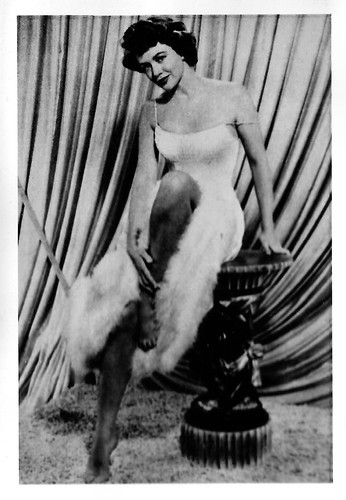
Small Dutch collector card.
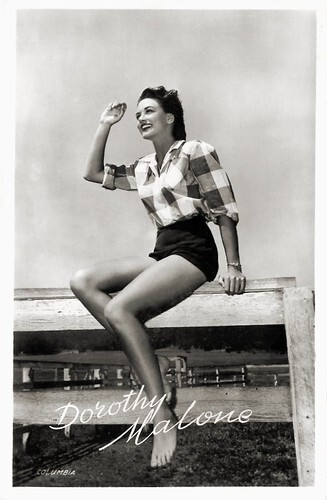
Dutch postcard, no. 3378. Photo: Columbia / Foto-archief Film en Toneel.
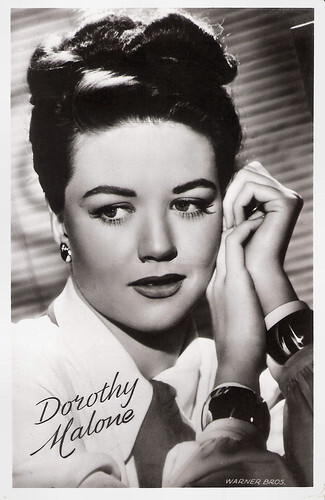
Dutch postcard, no. 174. Photo: Warner Bros.
She needed to gamble on her career
Dorothy Malone decided to recommit to her acting career and move to New York to study at the American Theater Wing. In between her studies, she worked for TV and appeared in B movies like Saddle Legion (Lesley Selander, 1951) and The Bushwhackers (Rod Amateau, 1951). Producer Hal Wallis called her back to Hollywood to appear in Scared Stiff (George Marshall, 1953) starring the comedy duo of Dean Martin and Jerry Lewis . She also appeared with the duo in the musical-comedy Artists and Models (Frank Tashlin, 1955) as the love interest of Martin's character.
After 11 years of mostly roles as loving sweethearts and wives, the brunette actress decided she needed to gamble on her career instead of playing it safe. She fired her agent, hired a publicist, dyed her hair blonde and sought a new image. First off was as a sister to Doris Day in Young at Heart (Gordon Douglas, 1954), a musical remake of Four Daughters (Michael Curtiz, 1938). The platinum blonde seemed to emphasize her overt and sensual beauty and she garnered even better attention when she appeared in the war pic Battle Cry (Raoul Walsh, 1955), in which she shared love scenes with heartthrob Tab Hunter.
She continued the momentum with the Westerns Five Guns West ( Roger Corman, 1955) and Tall Man Riding (Lesley Selander, 1955) starring Randolph Scott , but not with melodramatic romantic dud Sincerely Yours (Gordon Douglas, 1955) which tried to sell to the audiences a heterosexual Liberace . She signed with Universal and won the scenery-chewing role of Marylee Hadley in the soap opera Written on the Wind (Douglas Sirk, 1956) in which she played an alcoholic nymphomaniac who tries to steal Rock Hudson from his wife, Lauren Bacall . Gary Brumburgh at IMDb : "She won a supporting Oscar for her splendidly tramp, boozed-up Southern belle which was highlighted by her writhing mambo dance."
The Tarnished Angels (Douglas Sirk, 1957), which reunited Malone with Hudson faltered, and Quantez (Harry Keller, 1957) with Fred MacMurray was just another run-of-the-mill western. In Man of a Thousand Faces (Joseph Pevney, 1957) she played the unsympathetic first wife of James Cagney 's Lon Chaney Sr, Then she appeared as alcoholic actress Diana Barrymore in the biographic melodrama Too Much, Too Soon (Art Napoleon, 1958) opposite Errol Flynn .
At age 35, she married playboy actor Jacques Bergerac , Ginger Rogers' ex-husband, in 1959. A baby daughter, Mimi, was born the following year. Fewer film offers, which included Warlock (Edward Dmytryk, 1959) starring Richard Widmark , and The Last Voyage (Andrew L. Stone, 1960) with Robert Stack , came her way as Dorothy focused more on family life. A second daughter, Diane, was born in 1962.
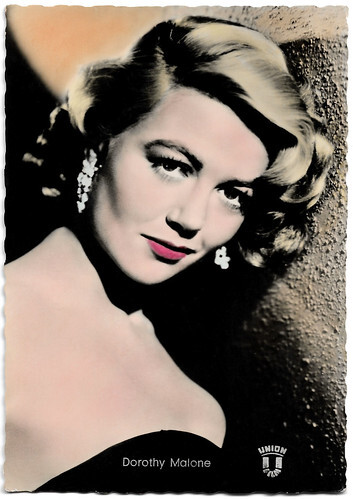
West German postcard in the Mimosa series by B.I.S.-Verlag, Stuttgart, no. 1146. Photo: Universal / Union-Film.
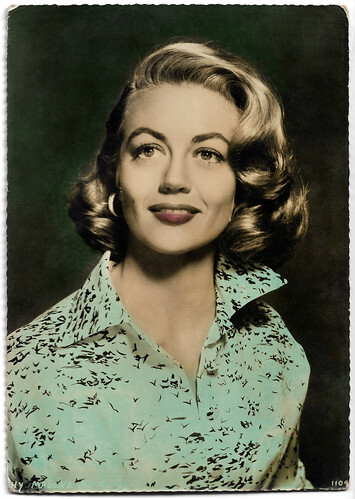
Yugoslavian postcard by ZK, no. 2913. Sent by mail in 1962.
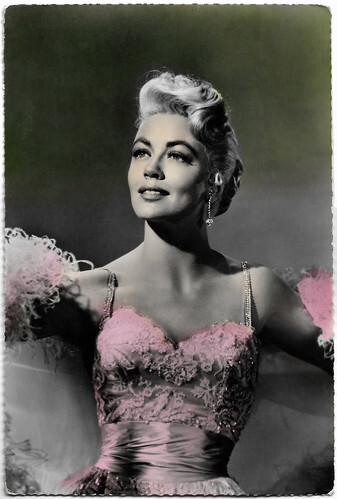
Yugoslavian postcard by ZK, no. 3904. Publicity still for Man of a Thousand Faces (Joseph Pevney, 1957).
TV's first prime-time soap opera
Dorothy Malone's turbulent marriage ended in 1964 in a divorce and a bitter custody battle with Dorothy eventually winning primary custody. It took the small screen to rejuvenate her career in the mid-1960s when she earned top billing for TV's first prime-time soap opera Peyton Place (1964). Dorothy starred as long-suffering Constance MacKenzie, the bookshop operator who harboured a dark secret about the birth of her daughter Allison, played by the 19-year-old Mia Farrow.
The series was a smash hit. The run wasn't entirely happy, however. Doctors discovered blood clots in her lungs which required major surgery and she almost died. Lola Albright filled in until she was able to return. Just as bad, the significance of her role dwindled with time and 20th Century Fox finally wrote her and co-star Tim O'Connor off the show in 1968. Dorothy filed a breach of contract lawsuit which ended in an out-of-court settlement.
She would later return to the role in the TV movies Murder in Peyton Place (Bruce Kessler, 1977) and Peyton Place: The Next Generation (Larry Elikann, 1985). Her life on- and off-camera did not improve. Dorothy's second marriage to stockbroker Robert Tomarkin in 1969 would last only three months, and a third to businessman Charles Huston Bell managed about three years.
Now-matronly roles in the films Winter Kills (William Richert, 1979), Off Your Rocker (Morley Markson, Larry Pall, 1982), The Being (Jackie Kong, 1983) and the Spanish-British horror film Descanse en piezas/Rest in Pieces (José Ramón Larraz, 1987), were few and far between a few TV-movies, did nothing to advance her.
Malone returned and settled for good back in Dallas, returning to Hollywood only on occasion. Her last film was the popular thriller Basic Instinct (Paul Verhoeven, 1992) as a friend to Sharon Stone , a mother convicted of murdering her family. Dorothy Malone died in a nursing facility in Dallas at the age of 92. Gary Brumburgh at IMDb: "She will be remembered as one of those Hollywood stars who proved she had the talent but somehow got the short end of the stick when it came to quality films offered."
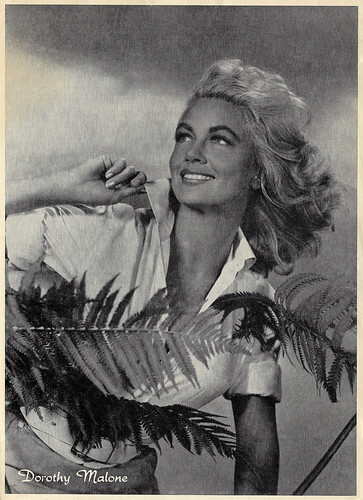
Vintage collector card.
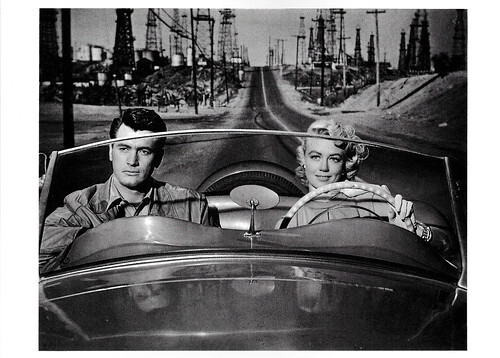
Swiss-German-British postcard by News Productions, Baulmes / Filmwelt Berlin, Bakede / News Productions, Stroud, no. 56498. Photo: Collection Cinémathèque Suisse, Lausanne. Rock Hudson and Dorothy Malone in Written on the Wind (Douglas Sirk, 1956), produced by Universal.
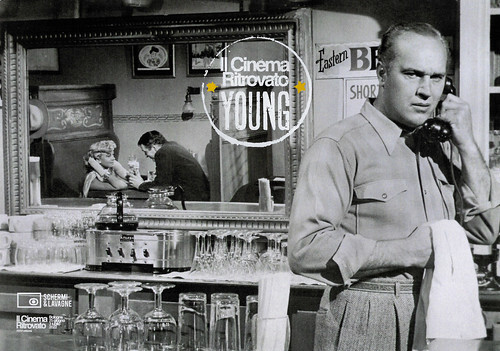
Big programme card by Cineteca Bologna for Il Cinema Ritrovato, XXXVI edizione, Selezione Cinema Ritrovato Young, 25 June 2022. Dorothy Malone and Robert Stack in Written on the Wind (Douglas Sirk, 1956).
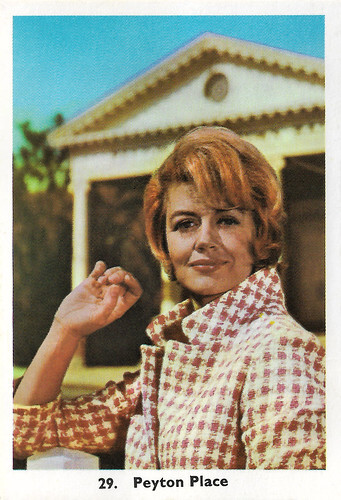
Vintage collectors card, no. 29. Dorothy Malone in the TV series Peyton Place (1964-1969).
Source: (IMDb), Ronald Bergan (The Guardian), Wikipedia and .

Spanish postcard by Edic. Raker, Barcelona, no. 247/6017.

French postcard by Editions P.I., Paris, no. 832, offered by Les Carbones Korès 'Carboplane'. Photo: Browning Studio H.P.S.

British postcard in the Picturegoer Series, London, no. D. 617. Photo: Warner.
A seductive book clerk
Dorothy Eloise Maloney was born in Chicago, Illinois, in 1925. She was one of five children born to an accountant father. Two older sisters died of polio. A younger brother later was killed by lightning while on a Dallas golf course. When she was a child, her family moved to Dallas, Texas. Attending Ursuline Convent and Highland Park High School, Dorothy was the 'School Favorite' and won several awards for swimming and horseback riding.
She modelled for Neiman Marcus. Following graduation, she studied at Southern Methodist University with the intent of becoming a nurse, but a role in the college play 'Starbound' happened to catch the eye of an RKO talent scout and she was offered a Hollywood contract.
At age 18, Dorothy Maloney made her film debut in Gildersleeve on Broadway (Gordon Douglas, 1943). The lovely brunette continued as an RKO starlet in the Frank Sinatra musicals Higher and Higher (Tim Whelan, 1943) and Step Lively (Tim Whelan, 1944), and a couple of the Falcon mysteries.
She had a showier role in Show Business (Edwin L. Marin, 1944) with Eddie Cantor . RKO lost interest, however, after the two-year contract was up. Warner Bros. offered the actress a contract. As Dorothy Malone, she played a seductive book clerk in the Humphrey Bogart / Lauren Bacall classic The Big Sleep (Howard Hawks, 1946).
Critics and audiences took notice and she got more visible roles in Two Guys from Texas (David Butler, 1948), South of St. Louis (Ray Enright, 1949) and Colorado Territory (Raoul Walsh, 1949). Despite this positive movement, Warner Bros. did not extend Dorothy's contract in 1949 and she returned to her family in Dallas and a steadier job with an insurance agency.

Small Dutch collector card.

Dutch postcard, no. 3378. Photo: Columbia / Foto-archief Film en Toneel.

Dutch postcard, no. 174. Photo: Warner Bros.
She needed to gamble on her career
Dorothy Malone decided to recommit to her acting career and move to New York to study at the American Theater Wing. In between her studies, she worked for TV and appeared in B movies like Saddle Legion (Lesley Selander, 1951) and The Bushwhackers (Rod Amateau, 1951). Producer Hal Wallis called her back to Hollywood to appear in Scared Stiff (George Marshall, 1953) starring the comedy duo of Dean Martin and Jerry Lewis . She also appeared with the duo in the musical-comedy Artists and Models (Frank Tashlin, 1955) as the love interest of Martin's character.
After 11 years of mostly roles as loving sweethearts and wives, the brunette actress decided she needed to gamble on her career instead of playing it safe. She fired her agent, hired a publicist, dyed her hair blonde and sought a new image. First off was as a sister to Doris Day in Young at Heart (Gordon Douglas, 1954), a musical remake of Four Daughters (Michael Curtiz, 1938). The platinum blonde seemed to emphasize her overt and sensual beauty and she garnered even better attention when she appeared in the war pic Battle Cry (Raoul Walsh, 1955), in which she shared love scenes with heartthrob Tab Hunter.
She continued the momentum with the Westerns Five Guns West ( Roger Corman, 1955) and Tall Man Riding (Lesley Selander, 1955) starring Randolph Scott , but not with melodramatic romantic dud Sincerely Yours (Gordon Douglas, 1955) which tried to sell to the audiences a heterosexual Liberace . She signed with Universal and won the scenery-chewing role of Marylee Hadley in the soap opera Written on the Wind (Douglas Sirk, 1956) in which she played an alcoholic nymphomaniac who tries to steal Rock Hudson from his wife, Lauren Bacall . Gary Brumburgh at IMDb : "She won a supporting Oscar for her splendidly tramp, boozed-up Southern belle which was highlighted by her writhing mambo dance."
The Tarnished Angels (Douglas Sirk, 1957), which reunited Malone with Hudson faltered, and Quantez (Harry Keller, 1957) with Fred MacMurray was just another run-of-the-mill western. In Man of a Thousand Faces (Joseph Pevney, 1957) she played the unsympathetic first wife of James Cagney 's Lon Chaney Sr, Then she appeared as alcoholic actress Diana Barrymore in the biographic melodrama Too Much, Too Soon (Art Napoleon, 1958) opposite Errol Flynn .
At age 35, she married playboy actor Jacques Bergerac , Ginger Rogers' ex-husband, in 1959. A baby daughter, Mimi, was born the following year. Fewer film offers, which included Warlock (Edward Dmytryk, 1959) starring Richard Widmark , and The Last Voyage (Andrew L. Stone, 1960) with Robert Stack , came her way as Dorothy focused more on family life. A second daughter, Diane, was born in 1962.

West German postcard in the Mimosa series by B.I.S.-Verlag, Stuttgart, no. 1146. Photo: Universal / Union-Film.

Yugoslavian postcard by ZK, no. 2913. Sent by mail in 1962.

Yugoslavian postcard by ZK, no. 3904. Publicity still for Man of a Thousand Faces (Joseph Pevney, 1957).
TV's first prime-time soap opera
Dorothy Malone's turbulent marriage ended in 1964 in a divorce and a bitter custody battle with Dorothy eventually winning primary custody. It took the small screen to rejuvenate her career in the mid-1960s when she earned top billing for TV's first prime-time soap opera Peyton Place (1964). Dorothy starred as long-suffering Constance MacKenzie, the bookshop operator who harboured a dark secret about the birth of her daughter Allison, played by the 19-year-old Mia Farrow.
The series was a smash hit. The run wasn't entirely happy, however. Doctors discovered blood clots in her lungs which required major surgery and she almost died. Lola Albright filled in until she was able to return. Just as bad, the significance of her role dwindled with time and 20th Century Fox finally wrote her and co-star Tim O'Connor off the show in 1968. Dorothy filed a breach of contract lawsuit which ended in an out-of-court settlement.
She would later return to the role in the TV movies Murder in Peyton Place (Bruce Kessler, 1977) and Peyton Place: The Next Generation (Larry Elikann, 1985). Her life on- and off-camera did not improve. Dorothy's second marriage to stockbroker Robert Tomarkin in 1969 would last only three months, and a third to businessman Charles Huston Bell managed about three years.
Now-matronly roles in the films Winter Kills (William Richert, 1979), Off Your Rocker (Morley Markson, Larry Pall, 1982), The Being (Jackie Kong, 1983) and the Spanish-British horror film Descanse en piezas/Rest in Pieces (José Ramón Larraz, 1987), were few and far between a few TV-movies, did nothing to advance her.
Malone returned and settled for good back in Dallas, returning to Hollywood only on occasion. Her last film was the popular thriller Basic Instinct (Paul Verhoeven, 1992) as a friend to Sharon Stone , a mother convicted of murdering her family. Dorothy Malone died in a nursing facility in Dallas at the age of 92. Gary Brumburgh at IMDb: "She will be remembered as one of those Hollywood stars who proved she had the talent but somehow got the short end of the stick when it came to quality films offered."

Vintage collector card.

Swiss-German-British postcard by News Productions, Baulmes / Filmwelt Berlin, Bakede / News Productions, Stroud, no. 56498. Photo: Collection Cinémathèque Suisse, Lausanne. Rock Hudson and Dorothy Malone in Written on the Wind (Douglas Sirk, 1956), produced by Universal.

Big programme card by Cineteca Bologna for Il Cinema Ritrovato, XXXVI edizione, Selezione Cinema Ritrovato Young, 25 June 2022. Dorothy Malone and Robert Stack in Written on the Wind (Douglas Sirk, 1956).

Vintage collectors card, no. 29. Dorothy Malone in the TV series Peyton Place (1964-1969).
Source: (IMDb), Ronald Bergan (The Guardian), Wikipedia and .
Published on March 11, 2024 23:00
March 10, 2024
Directed by Lucio D'Ambra
Lucio D'Ambra (1879-1939), was an Italian film writer, director and producer. Although he is best known for his work in the cinema, he was also a journalist, literary and theatre critic, playwright, artistic director of theatre companies and author of novels. D'Ambra became involved in the cinema in 1911 when he anonymously wrote screenplays. From 1916 he formally entered the film industry, setting up his own production company and directing more than twenty films. His silent comedies were compared to the films of Ernst Lubitsch.
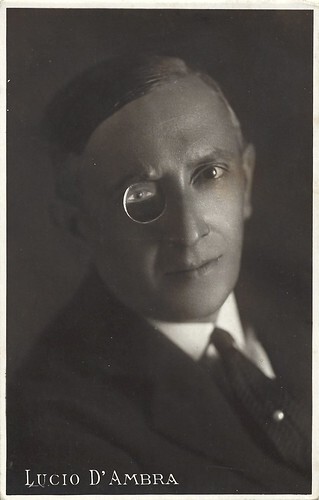
Italian postcard by Fotocelere, Torino.
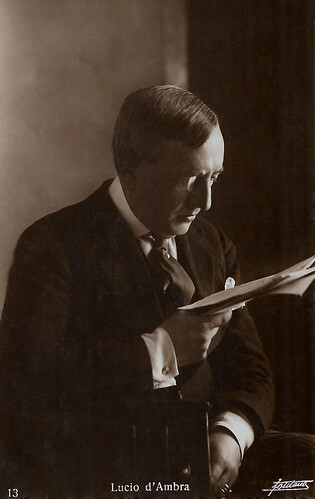
Italian postcard by Ed. A. Traldi, Milano, no. 13. Photo: Fontana.
A delicious Lubitsch-like comedy
Lucio D'Ambra was born Renato Eduardo Manganella in Rome, Italy, in 1879. According to some sources, his full name was Renato Tommaso Anacleto Manganella, and his year of birth was 1880.
D'Ambra was a journalist, literary and theatre critic, playwright and artistic director of theatre companies. Ettore Petrolini reduced his play 'Ambasciatori' to one of his shows. He was also a screenwriter for the cinema, an academic of Italy and an author of novels, including 'I due modi di avere vent'anni' (The Two Ways to be 20), published by Arnoldo Mondadori in 1934. He had the writer and poet Tullio Colsalvatico as his secretary and was in contact with the philosopher and critic Adriano Tilgher, with whom he polemised at length.
D'Ambra was also the animator of a literary salon which allowed him to come into contact with literary figures and personalities from the art world. He was friends with the writer Arturo Olivieri Sangiacomo, the playwright Tito Marrone and the founder of the Bagutta Prize, Marino Parenti. In 1923, he founded a company called Teatro degli Italiani at the Teatro Eliseo in Rome, together with Mario Fumagalli and Santi Severino. The aim of the company, subsidised by the Fascist regime to promote theatre in Italy, but with little success.
In 1911, he entered the cinema writing a screenplay of 'I promessi sposi' (The Betrothed) for the film of the same name by Ugo Falena. In 1913, he wrote the script for the film Il bacio di Cirano/The Kiss of Cyrano (Carmine Gallone, 1913) starring Soava Gallone . It was Carmine Gallone's debut film as a director. In 1916 D'Ambra started to work steadily in the cinema as a screenwriter for the company Medusa Film. First, he wrote the delicious Lubitsch-like comedy La signorina Ciclone/Miss Cyclone (Augusto Genina, 1916) with Suzanne Armelle as a dynamic New Yorkese heiress who keeps all of her seven admirers on a leash like dogs but in the end, prefers a European who possesses all seven sins the admirers represent individually.
Lucio D'Ambra also wrote scripts for star vehicles, such as Effetti di luce/Light Effects (Ugo Falena, 1916) with Stacia Napierkowska and La chiamavano 'Cosetta'/They called her 'Cosetta' (Eugenio Perego, 1917) with Soava Gallone , La storia dei tredici/The Thirteenth Man (Carmine Gallone, 1917) and Carnevalesca/Varnival (Amleto Palermi, 1918) both with Lyda Borelli . D'Ambra also scripted Medusa Il re, le torri, gli alfieri (Ivo Illuminati, 1920), a now-lost film which had affinities with Italian Futurism. The story, based on D'Ambra's novel, was a dramatisation of a chess game, where the characters were dressed as various pieces and moved around on a chessboard floor. For the company Do-Re-Mi, D'Ambra directed a series of films starring Mary Corwyn aka Maria Corvin : Napoleoncina (1918), Ballerine (1918), La commedia dal mio palco (1918), Passa il dramma a Lilliput (1919), and La valse bleue (1919), in which the actress often was paired with Romano Calò.
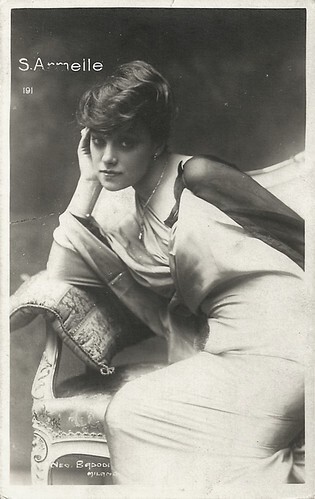
Italian postcard by Vettori, Bologna, no. 191. Photo by Badodi, Milano. Suzanne Armelle (?-?), born in Paris, had a career as a film actress in Italian silent cinema between the mid-1910s and the early 1920s. She is particularly remembered for her part as Miss Fluffy Ruffles in La Signorina Ciclone (Augusto Genina, 1916), written by Lucio D'Ambra.
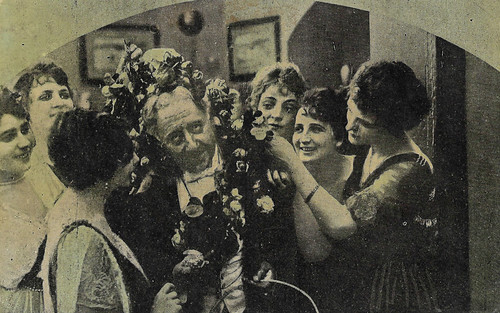
Spanish cromo (collector card) by Chocolate Imperiale, no. 3 of 6 cards. Photo: Cines / distr. J. Muntañola, Barcelona. Ugo Piperno in La storia dei tredici (Carmine Gallone, 1917), after a script by Lucio D'Ambra based on Honoré de Balzac's tripartite novel 'L'histoire des treize' (1833-39), published as 'Ferragus', 'La duchesse de Langeais' and 'La fille aux yeux d'or'.
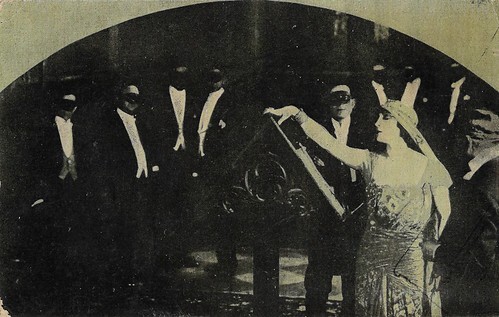
Spanish cromo by Chocolate Imperiale, no. 5 of 6 cards. Photo: Cines / distr. J. Muntañola, Barcelona. Lyda Borelli in La storia dei tredici (Carmine Gallone, 1917), after a script by Lucio D'Ambra based on Honoré de Balzac's tripartite novel 'L'histoire des treize' (1833-39), published as 'Ferragus', 'La duchesse de Langeais' and 'La fille aux yeux d'or'.
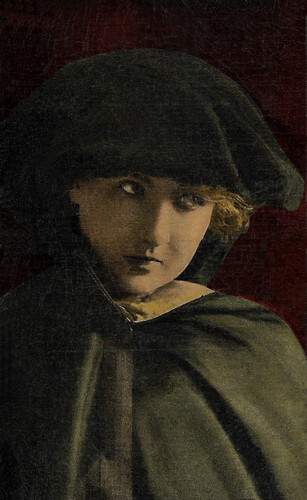
Spanish cromo by Chocolat Imperiale, Barcelona, no. 1 of 6 cards. Photo: Do-Re-Mi Film / Dist. J. Verdaguer, Barcelona. Maria Corvin aka Mary Corwyn in Napoleoncina (Lucio D'Ambra, 1918). The Spanish title of the film was Napoleoncilla.
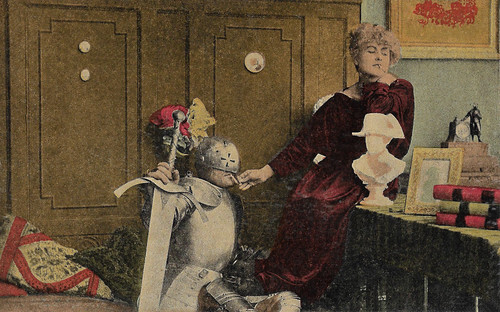
Spanish cromo by Chocolat Imperiale, Barcelona, no. 2 of 6 cromos. Photo: Do-Re-Mi Film / Dist. J. Verdaguer, Barcelona. Mary Corwyn in Napoleoncina (Lucio D'Ambra, 1918). The Spanish title of the film was Napoleoncilla.
A largely independent author and director
In 1919, in collaboration with the Piedmontese entrepreneur Alfredo Fasola, Lucio D'Ambra founded his own production company, D'Ambra-Film, with which directors Carmine Gallone, Augusto Genina and others collaborated, e.g. for Nemesis (Carmine Gallone, 1920) and La peccatrice senza peccato/Her Dreadful Secret (Augusto Genina, 1922), both starring Soava Gallone .
Yet, many films were directed by D'Ambra himself, such as Il girotondo degli undici lancieri/The round of the eleven lancers (1919) with Mary Corwyn and Romano Calò, and the witty short comedy L'illustre attrice Cicala Formica/The Illustrious Actress Cicala Formica (1920), with Lia Formia as a wannabe actress who to the frustration of her family pursues with all means to become a diva, but utterly fails. The film mocked the Italian diva and epic films, amateurism in the film world, but also the Italian family.
D'Ambra also directed serious drama, such as the Ugo Foscolo adaptation Le ultime lettere di Jacopo Ortis/The Last Letters of Jacopo Ortis (1921), on a man's despair about his inability to obtain the woman of his dreams. Until 1922 D'Ambra continued to direct and script various films at his company, often with Lia Formia in the lead, the last being Tragedia su tre carte/Tragedy on Three Cards (1922). In 1922 D'Ambra's company was absorbed into the conglomerate Unione Cinematografica Italiana and he retired from regular filmmaking. In the late 1930s, he returned but only as a screenwriter for a few films, including the comedy Occupati d’Amelia/Take Care of Amelia (Telemaco Ruggeri, 1925) starring Pina Menichelli and Marcel Lévesque .
On D'Ambra's film career, Italian scholar Gianni Rondolino wrote in the Enciclopedia Treccani : "A largely independent author and director, he was able to deal with themes and topics, situations and characters from the high society, but also from everyday life, with great fluency, in a style that took into account the linguistic peculiarities of cinema, skillfully using close-ups and camera movements, scenic effects and daring narrative solutions.
His films, considered forerunners of those of Ernst Lubitsch for the lightness of touch and the environments described, constitute a not inconsiderable chapter in the history of Italian silent films, for their formal innovation, after the more conventional splendour of the previous years, among historical reconstructions, novels of appendices, melodramas and farces." In 1937 he published his memoirs, recounting his time working in Italy's early film industry. Lucio D'Ambra died in 1939 in Rome. He was 59.
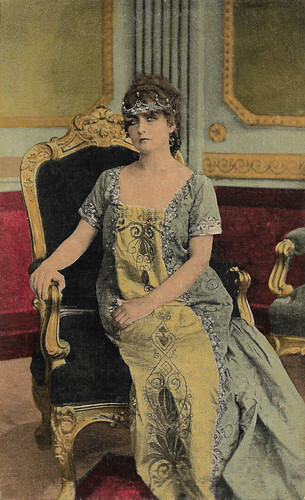
Spanish cromo by Chocolat Imperiale, Barcelona, no. 6 of 6 cards. Photo: Do-Re-Mi Film / Dist. J. Verdaguer, Barcelona. Maria Corvin aka Mary Corwyn in Napoleoncina (Lucio D'Ambra, 1918). The Spanish title of the film was Napoleoncilla.
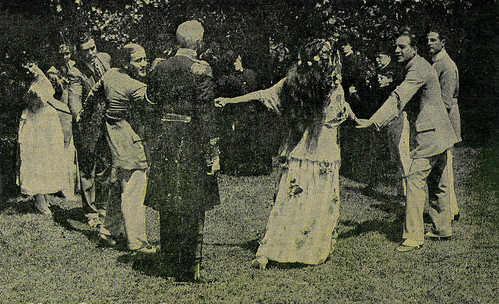
Spanish cromo by Amattler Marca Luna chocolate, series 7, no. 1. Photo: a scene from Carnevalesca (Amleto Palermi, 1918), after Lucio D'Ambra. Photography was by Giovanni Grimaldi. Here left of the marshall we see Livio Pavanelli and Augusto Poggioli, on the back in the flowery dress, Lyda Borelli , and right of her the unknown actor who plays Pietro.
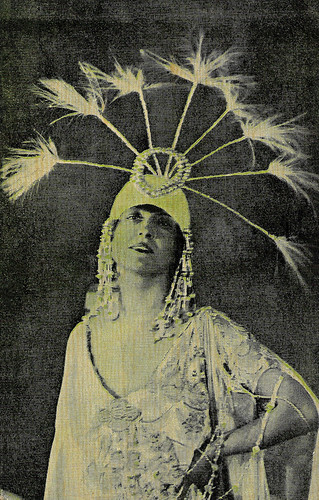
Spanish cromo by Amattler Marca Luna chocolate, series 7, no. 7. Lyda Borelli in Carnevalesca (Amleto Palermi, 1918), after Lucio D'Ambra. Photography was by Giovanni Grimaldi.
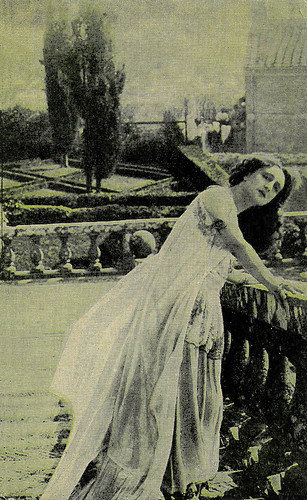
Spanish cromo by Amattler Marca Luna chocolate, series 7, no. 19. Lyda Borelli in Carnevalesca (Amleto Palermi, 1918), after Lucio D'Ambra. Photography was by Giovanni Grimaldi. On this card, Borelli's character, Queen Maria Teresa, flees the castle after having unjustly killed her husband.
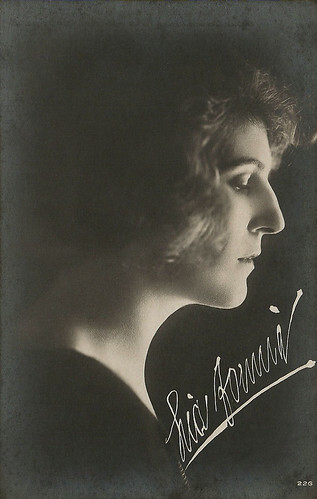
Italian postcard, no. 226. Collection: Didier Hanson. Italian actress Lia Formia appeared in 20 silent films between 1918 and 1925. For years she was the leading actress of director Lucio D'Ambra.
Sources: Gianni Rondolino (Enciclopedia Treccani), Wikipedia (Italian, French and English) and .

Italian postcard by Fotocelere, Torino.

Italian postcard by Ed. A. Traldi, Milano, no. 13. Photo: Fontana.
A delicious Lubitsch-like comedy
Lucio D'Ambra was born Renato Eduardo Manganella in Rome, Italy, in 1879. According to some sources, his full name was Renato Tommaso Anacleto Manganella, and his year of birth was 1880.
D'Ambra was a journalist, literary and theatre critic, playwright and artistic director of theatre companies. Ettore Petrolini reduced his play 'Ambasciatori' to one of his shows. He was also a screenwriter for the cinema, an academic of Italy and an author of novels, including 'I due modi di avere vent'anni' (The Two Ways to be 20), published by Arnoldo Mondadori in 1934. He had the writer and poet Tullio Colsalvatico as his secretary and was in contact with the philosopher and critic Adriano Tilgher, with whom he polemised at length.
D'Ambra was also the animator of a literary salon which allowed him to come into contact with literary figures and personalities from the art world. He was friends with the writer Arturo Olivieri Sangiacomo, the playwright Tito Marrone and the founder of the Bagutta Prize, Marino Parenti. In 1923, he founded a company called Teatro degli Italiani at the Teatro Eliseo in Rome, together with Mario Fumagalli and Santi Severino. The aim of the company, subsidised by the Fascist regime to promote theatre in Italy, but with little success.
In 1911, he entered the cinema writing a screenplay of 'I promessi sposi' (The Betrothed) for the film of the same name by Ugo Falena. In 1913, he wrote the script for the film Il bacio di Cirano/The Kiss of Cyrano (Carmine Gallone, 1913) starring Soava Gallone . It was Carmine Gallone's debut film as a director. In 1916 D'Ambra started to work steadily in the cinema as a screenwriter for the company Medusa Film. First, he wrote the delicious Lubitsch-like comedy La signorina Ciclone/Miss Cyclone (Augusto Genina, 1916) with Suzanne Armelle as a dynamic New Yorkese heiress who keeps all of her seven admirers on a leash like dogs but in the end, prefers a European who possesses all seven sins the admirers represent individually.
Lucio D'Ambra also wrote scripts for star vehicles, such as Effetti di luce/Light Effects (Ugo Falena, 1916) with Stacia Napierkowska and La chiamavano 'Cosetta'/They called her 'Cosetta' (Eugenio Perego, 1917) with Soava Gallone , La storia dei tredici/The Thirteenth Man (Carmine Gallone, 1917) and Carnevalesca/Varnival (Amleto Palermi, 1918) both with Lyda Borelli . D'Ambra also scripted Medusa Il re, le torri, gli alfieri (Ivo Illuminati, 1920), a now-lost film which had affinities with Italian Futurism. The story, based on D'Ambra's novel, was a dramatisation of a chess game, where the characters were dressed as various pieces and moved around on a chessboard floor. For the company Do-Re-Mi, D'Ambra directed a series of films starring Mary Corwyn aka Maria Corvin : Napoleoncina (1918), Ballerine (1918), La commedia dal mio palco (1918), Passa il dramma a Lilliput (1919), and La valse bleue (1919), in which the actress often was paired with Romano Calò.

Italian postcard by Vettori, Bologna, no. 191. Photo by Badodi, Milano. Suzanne Armelle (?-?), born in Paris, had a career as a film actress in Italian silent cinema between the mid-1910s and the early 1920s. She is particularly remembered for her part as Miss Fluffy Ruffles in La Signorina Ciclone (Augusto Genina, 1916), written by Lucio D'Ambra.

Spanish cromo (collector card) by Chocolate Imperiale, no. 3 of 6 cards. Photo: Cines / distr. J. Muntañola, Barcelona. Ugo Piperno in La storia dei tredici (Carmine Gallone, 1917), after a script by Lucio D'Ambra based on Honoré de Balzac's tripartite novel 'L'histoire des treize' (1833-39), published as 'Ferragus', 'La duchesse de Langeais' and 'La fille aux yeux d'or'.

Spanish cromo by Chocolate Imperiale, no. 5 of 6 cards. Photo: Cines / distr. J. Muntañola, Barcelona. Lyda Borelli in La storia dei tredici (Carmine Gallone, 1917), after a script by Lucio D'Ambra based on Honoré de Balzac's tripartite novel 'L'histoire des treize' (1833-39), published as 'Ferragus', 'La duchesse de Langeais' and 'La fille aux yeux d'or'.

Spanish cromo by Chocolat Imperiale, Barcelona, no. 1 of 6 cards. Photo: Do-Re-Mi Film / Dist. J. Verdaguer, Barcelona. Maria Corvin aka Mary Corwyn in Napoleoncina (Lucio D'Ambra, 1918). The Spanish title of the film was Napoleoncilla.

Spanish cromo by Chocolat Imperiale, Barcelona, no. 2 of 6 cromos. Photo: Do-Re-Mi Film / Dist. J. Verdaguer, Barcelona. Mary Corwyn in Napoleoncina (Lucio D'Ambra, 1918). The Spanish title of the film was Napoleoncilla.
A largely independent author and director
In 1919, in collaboration with the Piedmontese entrepreneur Alfredo Fasola, Lucio D'Ambra founded his own production company, D'Ambra-Film, with which directors Carmine Gallone, Augusto Genina and others collaborated, e.g. for Nemesis (Carmine Gallone, 1920) and La peccatrice senza peccato/Her Dreadful Secret (Augusto Genina, 1922), both starring Soava Gallone .
Yet, many films were directed by D'Ambra himself, such as Il girotondo degli undici lancieri/The round of the eleven lancers (1919) with Mary Corwyn and Romano Calò, and the witty short comedy L'illustre attrice Cicala Formica/The Illustrious Actress Cicala Formica (1920), with Lia Formia as a wannabe actress who to the frustration of her family pursues with all means to become a diva, but utterly fails. The film mocked the Italian diva and epic films, amateurism in the film world, but also the Italian family.
D'Ambra also directed serious drama, such as the Ugo Foscolo adaptation Le ultime lettere di Jacopo Ortis/The Last Letters of Jacopo Ortis (1921), on a man's despair about his inability to obtain the woman of his dreams. Until 1922 D'Ambra continued to direct and script various films at his company, often with Lia Formia in the lead, the last being Tragedia su tre carte/Tragedy on Three Cards (1922). In 1922 D'Ambra's company was absorbed into the conglomerate Unione Cinematografica Italiana and he retired from regular filmmaking. In the late 1930s, he returned but only as a screenwriter for a few films, including the comedy Occupati d’Amelia/Take Care of Amelia (Telemaco Ruggeri, 1925) starring Pina Menichelli and Marcel Lévesque .
On D'Ambra's film career, Italian scholar Gianni Rondolino wrote in the Enciclopedia Treccani : "A largely independent author and director, he was able to deal with themes and topics, situations and characters from the high society, but also from everyday life, with great fluency, in a style that took into account the linguistic peculiarities of cinema, skillfully using close-ups and camera movements, scenic effects and daring narrative solutions.
His films, considered forerunners of those of Ernst Lubitsch for the lightness of touch and the environments described, constitute a not inconsiderable chapter in the history of Italian silent films, for their formal innovation, after the more conventional splendour of the previous years, among historical reconstructions, novels of appendices, melodramas and farces." In 1937 he published his memoirs, recounting his time working in Italy's early film industry. Lucio D'Ambra died in 1939 in Rome. He was 59.

Spanish cromo by Chocolat Imperiale, Barcelona, no. 6 of 6 cards. Photo: Do-Re-Mi Film / Dist. J. Verdaguer, Barcelona. Maria Corvin aka Mary Corwyn in Napoleoncina (Lucio D'Ambra, 1918). The Spanish title of the film was Napoleoncilla.

Spanish cromo by Amattler Marca Luna chocolate, series 7, no. 1. Photo: a scene from Carnevalesca (Amleto Palermi, 1918), after Lucio D'Ambra. Photography was by Giovanni Grimaldi. Here left of the marshall we see Livio Pavanelli and Augusto Poggioli, on the back in the flowery dress, Lyda Borelli , and right of her the unknown actor who plays Pietro.

Spanish cromo by Amattler Marca Luna chocolate, series 7, no. 7. Lyda Borelli in Carnevalesca (Amleto Palermi, 1918), after Lucio D'Ambra. Photography was by Giovanni Grimaldi.

Spanish cromo by Amattler Marca Luna chocolate, series 7, no. 19. Lyda Borelli in Carnevalesca (Amleto Palermi, 1918), after Lucio D'Ambra. Photography was by Giovanni Grimaldi. On this card, Borelli's character, Queen Maria Teresa, flees the castle after having unjustly killed her husband.

Italian postcard, no. 226. Collection: Didier Hanson. Italian actress Lia Formia appeared in 20 silent films between 1918 and 1925. For years she was the leading actress of director Lucio D'Ambra.
Sources: Gianni Rondolino (Enciclopedia Treccani), Wikipedia (Italian, French and English) and .
Published on March 10, 2024 23:00
March 9, 2024
Kay Kendall
Kay Kendall (1927-1959) was a British film actress and comedienne. The comedy Genevieve (1953) brought her widespread recognition and she won a Golden Globe for the musical-comedy Les Girls (1957). Kendall died of leukaemia, at the age of 32. She was married to Rex Harrison.
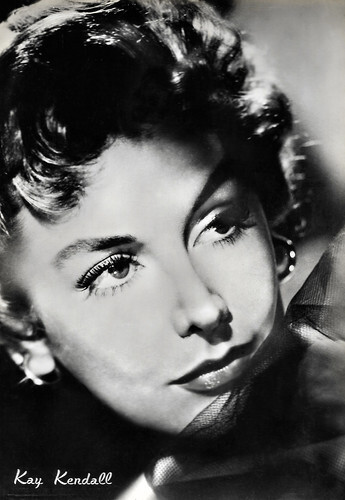
Italian postcard by S.A. Poligrafica Sammarinese, no. 025d.
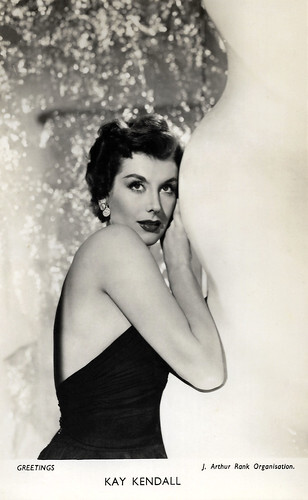
British postcard in the Greetings series, London. Photo: J. Arthur Rank Organisation.
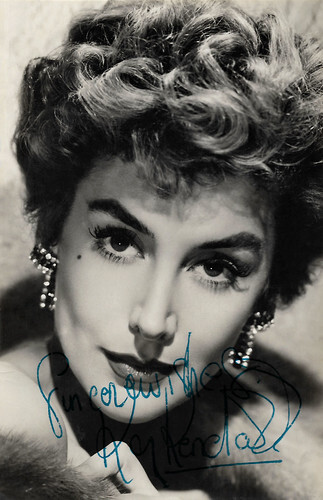
British autograph card by J. Arthur Rank Organisation.
A pitch-perfect screen performance
Kay Kendall was born Justine Kay Kendall-McCarthy in 1927 in Withernsea, Yorkshire, England. She was the second daughter of a theatrical couple, Terrence "Terry" McCarthy and Gladys Drewery. Her grandmother, Marie Kendall, was an Edwardian music hall legend. Kay studied ballet for six years in London. Kendall left school at the age of 12 to appear in revue.
Two years later, she toured English music halls in a double act with her sister Kim Kendall. During the war, she toured with ENSA singing and dancing, before switching to acting. From her mid-teens, she worked as an extra for Ealing Studios but soon graduated to bigger bit parts. At seventeen she landed a major role in the ambitious musical London Town (Wesley Ruggles, 1946) starring Sid Field. The film is best known for its massive box office failure.
Kendall returned to the theatre and bit parts in films. She co-starred with Petula Clark and Diana Dors in the drama Dance Hall (Charles Crichton, 1950). Unusually for an Ealing production of the time, the film tells the story of the four women and their romantic encounters from a female perspective, presumably the input of screenwriter Diana Morgan. After It Started in Paradise (Compton Bennett, 1952) she secured a Rank contract.
Her appearance in the comedy Genevieve (Henry Cornelius, 1953) brought her widespread recognition. Dylan Cave at BFI Screenonline : "Many film actors spend a career looking for a defining moment; a screen performance so pitch-perfect that their name is indelibly stamped on the public consciousness and stardom is assured. Kay Kendall had such a moment in one of British cinema's most parochial films. Her vivacious Rosalie Peters in Genevieve (d. Henry Cornelius, 1953) secured her future as a star, but now unfairly summarises the extent of her fame."
Kendall followed this with the even more popular comedy Doctor in the House (Ralph Thomas, 1954), the first film in the Doctor series with Dirk Bogarde . She was under contract to the Rank Organisation but was unhappy with the parts offered. She appeared with Peter Finch in the comedy Simon and Laura (Muriel Box, 1955), satirising the early days of BBC Television. Then followed the comedy Abdulla the Great (Gregory Ratoff, 1955) with Sydney Chaplin, the second son of actor Charlie Chaplin , with whom she had an affair. Her first big-budget film was the historical epic The Adventures of Quentin Durward (Richard Thorpe, 1955) with Robert Taylor .

British postcard in the Picturegoer Series, London, no. D 330. Photo: J. Arthur Rank Organisation.

British postcard in the Film Star Autograph Portrait Series, no. 62 Photo: J. Arthur Rank Organisation.
An instinctive comedienne with a real clown sense
Kay Kendall began a romantic relationship with actor Rex Harrison after they appeared together in the comedy The Constant Husband (Sidney Gilliat, 1955). Harrison was married at the time.
According to legend, he learned of Kay's leukaemia from her doctor and divorced Lilli Palmer . He married Kay in 1957, agreeing with the doctor never to tell her the reason for her failing health.
Prolific in British films, Kendall achieved some popularity with American audiences and won a Golden Globe Award for her role as Lady Sybil Wren in the musical-comedy film Les Girls (George Cukor, 1957), the story of three showgirls in postwar Paris with Mitzi Gaynor and Taina Elg.
The following year, she and Harrison starred together in The Reluctant Debutante (Vincente Minnelli, 1958). They lived the good life up until the end. In 1959 Kay Kendall died of leukaemia, at the age of 32. Her last film, released posthumously, was the comedy Once More, with Feeling! (Stanley Donen, 1960), with Yul Brynner .
Wikipedia cites Stanley Donen: "She was completely unpredictable. She was an instinctive comedienne with a real clown sense. No one has had it since Carole Lombard – and Kay was a better actress." Kendall's gravesite is in the churchyard of St John-at-Hampstead Church. Kendall's life is recounted in the 2002 biography 'The Brief, Madcap Life of Kay Kendall' by Eve Golden and Kim Elizabeth Kendall.
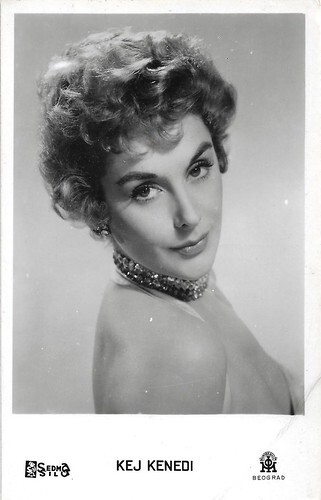
Yugoslavian postcard by Sedma Sila. Photo: Morava Film, Beograd (Belgrade). 'Kay Kennedy' is a misspelling of Kay Kendall.
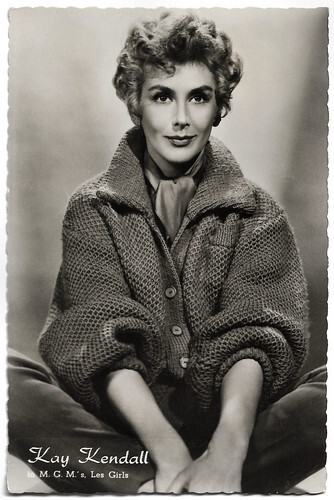
Vintage postcard, no. 14. Photo: M.G.M. Kay Kendall in Les Girls (George Cukor, 1957).
Sources: Dylan Cave (Screenonline), Find A Grave, Wikipedia and .

Italian postcard by S.A. Poligrafica Sammarinese, no. 025d.

British postcard in the Greetings series, London. Photo: J. Arthur Rank Organisation.

British autograph card by J. Arthur Rank Organisation.
A pitch-perfect screen performance
Kay Kendall was born Justine Kay Kendall-McCarthy in 1927 in Withernsea, Yorkshire, England. She was the second daughter of a theatrical couple, Terrence "Terry" McCarthy and Gladys Drewery. Her grandmother, Marie Kendall, was an Edwardian music hall legend. Kay studied ballet for six years in London. Kendall left school at the age of 12 to appear in revue.
Two years later, she toured English music halls in a double act with her sister Kim Kendall. During the war, she toured with ENSA singing and dancing, before switching to acting. From her mid-teens, she worked as an extra for Ealing Studios but soon graduated to bigger bit parts. At seventeen she landed a major role in the ambitious musical London Town (Wesley Ruggles, 1946) starring Sid Field. The film is best known for its massive box office failure.
Kendall returned to the theatre and bit parts in films. She co-starred with Petula Clark and Diana Dors in the drama Dance Hall (Charles Crichton, 1950). Unusually for an Ealing production of the time, the film tells the story of the four women and their romantic encounters from a female perspective, presumably the input of screenwriter Diana Morgan. After It Started in Paradise (Compton Bennett, 1952) she secured a Rank contract.
Her appearance in the comedy Genevieve (Henry Cornelius, 1953) brought her widespread recognition. Dylan Cave at BFI Screenonline : "Many film actors spend a career looking for a defining moment; a screen performance so pitch-perfect that their name is indelibly stamped on the public consciousness and stardom is assured. Kay Kendall had such a moment in one of British cinema's most parochial films. Her vivacious Rosalie Peters in Genevieve (d. Henry Cornelius, 1953) secured her future as a star, but now unfairly summarises the extent of her fame."
Kendall followed this with the even more popular comedy Doctor in the House (Ralph Thomas, 1954), the first film in the Doctor series with Dirk Bogarde . She was under contract to the Rank Organisation but was unhappy with the parts offered. She appeared with Peter Finch in the comedy Simon and Laura (Muriel Box, 1955), satirising the early days of BBC Television. Then followed the comedy Abdulla the Great (Gregory Ratoff, 1955) with Sydney Chaplin, the second son of actor Charlie Chaplin , with whom she had an affair. Her first big-budget film was the historical epic The Adventures of Quentin Durward (Richard Thorpe, 1955) with Robert Taylor .

British postcard in the Picturegoer Series, London, no. D 330. Photo: J. Arthur Rank Organisation.

British postcard in the Film Star Autograph Portrait Series, no. 62 Photo: J. Arthur Rank Organisation.
An instinctive comedienne with a real clown sense
Kay Kendall began a romantic relationship with actor Rex Harrison after they appeared together in the comedy The Constant Husband (Sidney Gilliat, 1955). Harrison was married at the time.
According to legend, he learned of Kay's leukaemia from her doctor and divorced Lilli Palmer . He married Kay in 1957, agreeing with the doctor never to tell her the reason for her failing health.
Prolific in British films, Kendall achieved some popularity with American audiences and won a Golden Globe Award for her role as Lady Sybil Wren in the musical-comedy film Les Girls (George Cukor, 1957), the story of three showgirls in postwar Paris with Mitzi Gaynor and Taina Elg.
The following year, she and Harrison starred together in The Reluctant Debutante (Vincente Minnelli, 1958). They lived the good life up until the end. In 1959 Kay Kendall died of leukaemia, at the age of 32. Her last film, released posthumously, was the comedy Once More, with Feeling! (Stanley Donen, 1960), with Yul Brynner .
Wikipedia cites Stanley Donen: "She was completely unpredictable. She was an instinctive comedienne with a real clown sense. No one has had it since Carole Lombard – and Kay was a better actress." Kendall's gravesite is in the churchyard of St John-at-Hampstead Church. Kendall's life is recounted in the 2002 biography 'The Brief, Madcap Life of Kay Kendall' by Eve Golden and Kim Elizabeth Kendall.

Yugoslavian postcard by Sedma Sila. Photo: Morava Film, Beograd (Belgrade). 'Kay Kennedy' is a misspelling of Kay Kendall.

Vintage postcard, no. 14. Photo: M.G.M. Kay Kendall in Les Girls (George Cukor, 1957).
Sources: Dylan Cave (Screenonline), Find A Grave, Wikipedia and .
Published on March 09, 2024 22:00
March 8, 2024
Mel Ferrer
American film actor, director and producer Mel Ferrer (1917-2008) was a key figure in Hollywood cinema in the 1950s and 1960s. He is best remembered for the role of the lame puppeteer in Lili (1953) and as Prince Andrei in War and Peace (1956). He also starred in such period films as Scaramouche (1952) and The Knights of the Round Table (1953). As a producer, he achieved success with the thriller Wait Until Dark (1967), in which his wife Audrey Hepburn starred.
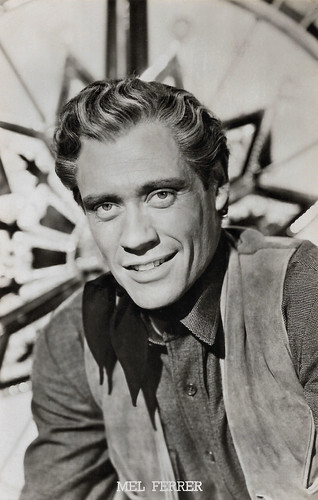
Vintage postcard, no. 952. Photo: R.K.O. Mel Ferrer in Rancho Notorious (Fritz Lang, 1952).
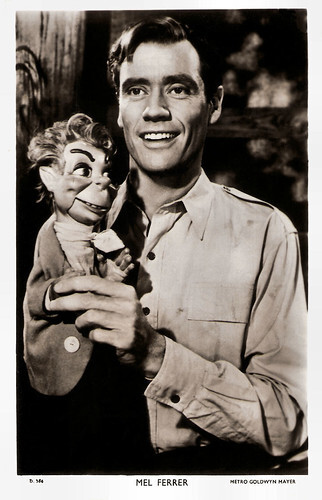
British postcard in the Picturegoer Series, London, no. D. 364. Photo: Metro-Goldwyn-Mayer. Mel Ferrer in Lili (Charles Walters, 1953).
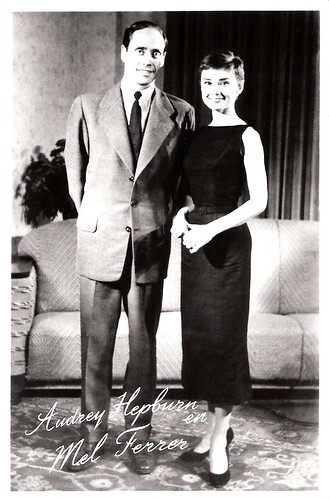
Dutch postcard by Takken, Utrecht, no. 1598. Audrey Hepburn and Mel Ferrer.
Assistant to John Ford
Melchor Gaston 'Mel' Ferrer was born in Elberon, New Jersey, in 1917. His father, who died in 1920, was a Cuban-born surgeon and chief of staff at St Vincent's Hospital in New York. His mother was Mary Matilda Irene O'Donohue, the daughter of Joseph J. O'Donohue, a coffee merchant who had become a commissioner in the New York City Department of Parks and Recreation. Ferrer had two sisters and a brother.
Mel attended Bovée School in New York and Canterbury Prep School in Connecticut. Het studied briefly at Princeton University and made his stage debut in the play 'Awhile to Work', for which he won the Theatre Intime award for best new play by a Princeton student. His partner was Frances Pilchard, whom he married in 1937. At 21, he performed as a chorus dancer on Broadway in 1938 in two musicals.
Two years later, he made his Broadway debut as an actor. After contracting polio, he first worked as a disc jockey in Texas and Arkansas and then moved to Mexico to devote himself to writing the novel 'Tito's Hat', published in 1940. He eventually returned to Broadway and entered the film business. He also directed and produced several radio programmes for NBC.
He made his modest directorial debut with the drama The Girl of the Limberlost (Mel Ferrer, 1945). He returned to acting on Broadway to star in Lillian Smith's 'Strange Fruit' and then assisted John Ford on the set of The Fugitive (John Ford, 1947) starring Henry Fonda and Dolores del Rio , in which he also made a small appearance.
Along with Gregory Peck , Dorothy McGuire and Joseph Cotten , he founded the La Jolla Playhouse in San Diego. He directed Claudette Colbert in The Secret Fury (Mel Ferrer, 1950) and got his first real role in the drama Lost Boundaries (Alfred L. Werker, 1949) with Beatrice Pearson, where he played a light-skinned doctor from New Zealand, who passed for white while living in New England in the 1930s and 1940s. The film won the 1949 Cannes Film Festival award for Best Screenplay.
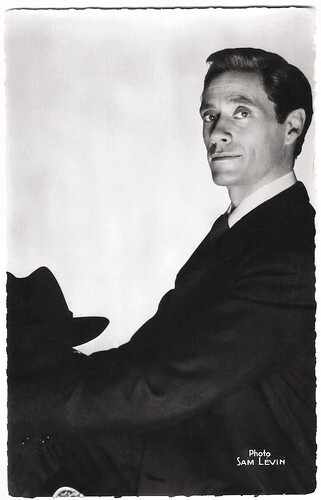
French postcard by Edition du Globe, Paris, no. 447. Photo: Sam Lévin.
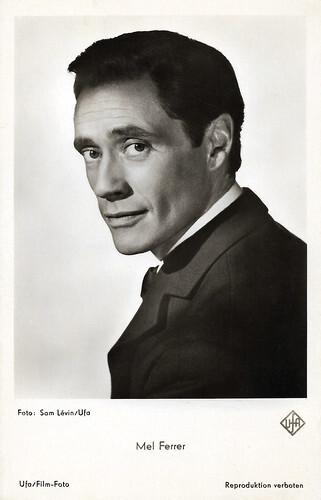
West German postcard by Ufa/Film-Foto, Berlin-Tempelhof, no. FK 4383. Photo: Sam Lévin / Ufa.
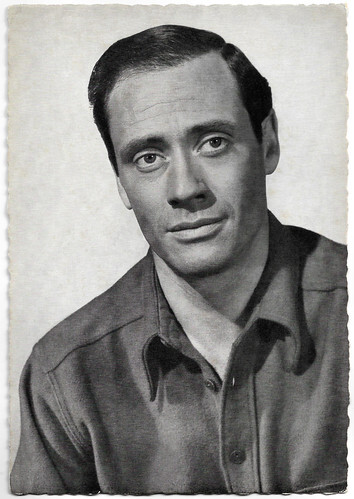
West German postcard by WS-Druck, Wanne-Eickel, no. 254. Photo: MGM / Archiv Filmpress Zürich.
'Hi-Lili-Hi-Lo'
After being noticed, Mel Ferrer went on to play more important roles, notably in Born to Be Bad (Nicholas Ray, 1950). The following year, he played Marlene Dietrich 's lover in the Western Rancho Notorious (Fritz Lang, 1951).
Then he played the Marquis of Maynes in the classic Swashbuckler Scaramouche (George Sidney, 1952) opposite Stewart Granger and Janet Leigh . The film, particularly notable for a long, climactic sword fight between Ferrer and Granger, was a huge hit. In 1953, he played opposite Leslie Caron in the musical Lili (Charles Walters, 1953). It was another big success. Ferrer and Caron also got a hit single out of it, 'Hi-Lili-Hi-Lo'.
That same year, he met Audrey Hepburn and immediately thought of her for a play by Jean Giraudoux, 'Ondine' (1954), on Broadway. The two fell in love and married in 1954 in Switzerland. Mel Ferrer made a name for himself on screen in the British historical adventure film The Knights of the Round Table (Richard Thorpe, 1953), where he played King Arthur, who competed with Robert Taylor for the love of Ava Gardner .
He played a dashing captain in the British musical comedy Oh Rosalinda (Michael Powell, Emeric Pressburger, 1955). With Audrey Hepburn and Henry Fonda , he starred in the blockbuster War and Peace (King Vidor, 1956), based on Leo Tolstoy's 1869 novel of the same name. With a huge budget, thousands of extras and historical reconstructions, it was a long, tough shoot, but the film was a success. Mel Ferrer played a very dignified Prince Andrei.
The following year, he was one of Ingrid Bergman 's suitors in Elena et les Hommes/Elena and Her Men (Jean Renoir, 1956), then a tormented writer in The Sun Also Rises (Henry King, 1957), an all-star adaptation of the 1926 Ernest Hemingway novel of the same name. He returned to directing with Green Mansions (Mel Ferrer, 1959), starring Audrey Hepburn , in which he had a part of the Amazon rainforest reconstructed in the studio.
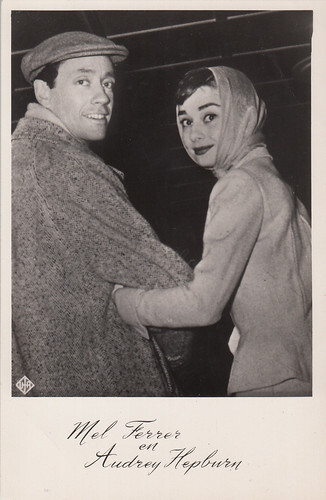
Dutch postcard by Takken, Utrecht, no. AX 1912. Photo: Ufa. Audrey Hepburn and Mel Ferrer. Collection: Marlene Pilaete.
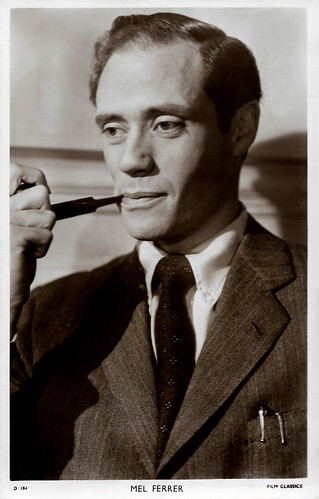
British postcard in the Picturegoer Series, London, no. D. 184. Photo: Film Classics.
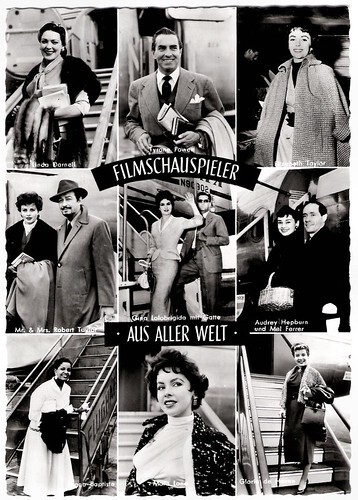
German postcard by Kunst und Film Verlag H. Lukow, Hannover, no. L2/1042. Caption: Filmschauspieler aus aller Welt (Film actors from around the world). From top left to down right: Linda Darnell , Tyrone Power , Elizabeth Taylor , Robert Taylor and his wife Ursula Thiess , Gina Lollobrigida and her husband Milko Skofic, Audrey Hepburn and Mel Ferrer, Mona Baptiste, Mara Lane and Gloria DeHaven .
A complex and tormented man
In 1961, Mel Ferrer took part in the war film The Longest Day (Bernhard Wicki, Andrew Morton, Ken Annakin, 1962) alongside an all-star cast including John Wayne , Henry Fonda and Robert Mitchum . Another major production, albeit a failure, was Anthony Mann's The Fall of the Roman Empire (1963). He then embarked on a more international career, shooting extensively in Europe, notably in France for Julien Duvivier and in Italy for Luciano Salce.
In an atypical role, Mel Ferrer played French priest and educational reformer Jean-Baptiste de La Salle in the Spanish biopic El señor de La Salle/Who Are My Own (Luis César Amadori, 1964). In Spain, he also directed his last film, a musical with teen star Marisol , Cabriola (Mel Ferrer, 1965). In 1967, he produced the psychological thriller Wait Until Dark (Terence Young, 1967), his last collaboration with Audrey Hepburn , whom he encouraged to accept the role. They separated the following year. A complex and tormented man, he never really accepted the fact that his wife was more famous than he was.
During the 1970s, he appeared in several Italian cult films, including the supernatural horror film L'anticristo/The Antichrist (Alberto De Martino, 1974), the Giallo Morte sospetta di una minorenne/The Suspicious Death of a Minor (Sergio Martino, 1975), the Swashbuckler Il corsaro nero/The Black Corsair (Sergio Sollima, 1976) starring Kabir Bedi, and the Science-Fiction Horror film Incubo sulla città contaminata/Nightmare City (Umberto Lenzi, 1980).
He went to Germany for two interesting films. Wolfgang Staudte's last feature film, Zwischengleis/Yesterday's Tomorrow (1978) with Pola Kinski, and Rainer Werner Fassbinder 's Lili Marleen (1981) starring Hanna Schygulla . From 1981 to 1984, he also rose to prominence among television viewers through his part in the TV series Falcon Crest in which he played the role of Philip Erickson, the rogue lawyer of leading lady Angela (Jane Wyman), whom he eventually married briefly. He also appeared in the TV Mini-Series Peter the Great (Marvin J. Chomsky, Lawrence Schiller, 1986) starring Maximilian Schell . His final film was the action film Eye of the Widow (Andrew V. MacLaglen, 1991).
Ferrer directed more than 10 films and acted in more than eighty. For his part in the film industry, Mel Ferrer received a star on the Hollywood Walk of Fame at 6268 Hollywood Blvd. Ferrer married five times. His first and third marriages were to the same woman, Frances Gulby Pilchard, the first from 1937 to 1939, the second in 1944, both marriages ended in divorce. His second marriage (1940) was to Barbara C. Tripp, this marriage also ended in divorce. His fourth marriage was to Audrey Hepburn , from 1954 to 1968. His fifth marriage, in 1971, was to Elizabeth Soukhoutine. He had six children, including Sean Hepburn Ferrer with Audrey Hepburn . Mel Ferrer died of heart failure at a convalescent home in Santa Barbara, California, in 2008, aged 90.
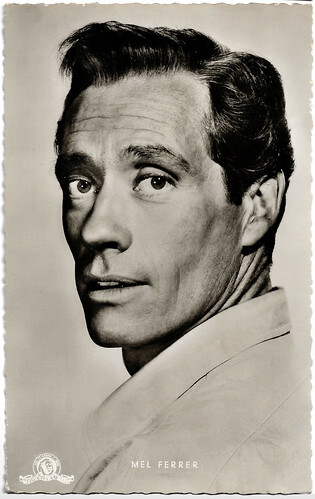
German postcard by Kunst und Bild, Berlin-Charlottenburg, no. S 760. Photo: Metro Goldwyn Mayer. Mel Ferrer in The Vintage (Jeffrey Hayden, 1957).
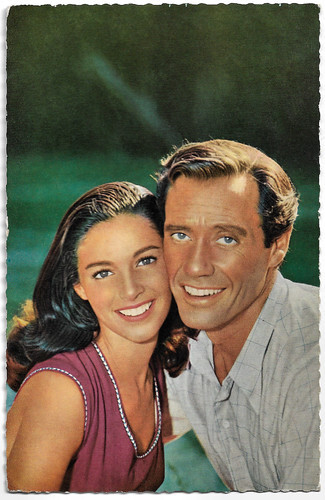
German postcard by Kunst und Bild, Berlin-Charlottenburg, no. C D 22. Photo: M.G.M. Pier Angeli and Mel Ferrer in The Vintage (Jeffrey Hayden, 1957).
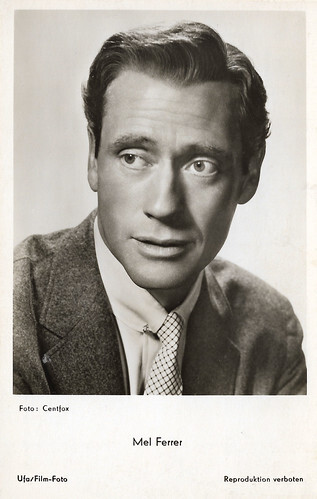
West German postcard by Ufa/Film-Foto, Berlin-Tempelhof, no. FK 3819. Photo: Centfox (20th Century Fox). Mel Ferrer in Fräulein (Henry Koster, 1958).
Sources: Wikipedia (Dutch, French and English) and .

Vintage postcard, no. 952. Photo: R.K.O. Mel Ferrer in Rancho Notorious (Fritz Lang, 1952).

British postcard in the Picturegoer Series, London, no. D. 364. Photo: Metro-Goldwyn-Mayer. Mel Ferrer in Lili (Charles Walters, 1953).

Dutch postcard by Takken, Utrecht, no. 1598. Audrey Hepburn and Mel Ferrer.
Assistant to John Ford
Melchor Gaston 'Mel' Ferrer was born in Elberon, New Jersey, in 1917. His father, who died in 1920, was a Cuban-born surgeon and chief of staff at St Vincent's Hospital in New York. His mother was Mary Matilda Irene O'Donohue, the daughter of Joseph J. O'Donohue, a coffee merchant who had become a commissioner in the New York City Department of Parks and Recreation. Ferrer had two sisters and a brother.
Mel attended Bovée School in New York and Canterbury Prep School in Connecticut. Het studied briefly at Princeton University and made his stage debut in the play 'Awhile to Work', for which he won the Theatre Intime award for best new play by a Princeton student. His partner was Frances Pilchard, whom he married in 1937. At 21, he performed as a chorus dancer on Broadway in 1938 in two musicals.
Two years later, he made his Broadway debut as an actor. After contracting polio, he first worked as a disc jockey in Texas and Arkansas and then moved to Mexico to devote himself to writing the novel 'Tito's Hat', published in 1940. He eventually returned to Broadway and entered the film business. He also directed and produced several radio programmes for NBC.
He made his modest directorial debut with the drama The Girl of the Limberlost (Mel Ferrer, 1945). He returned to acting on Broadway to star in Lillian Smith's 'Strange Fruit' and then assisted John Ford on the set of The Fugitive (John Ford, 1947) starring Henry Fonda and Dolores del Rio , in which he also made a small appearance.
Along with Gregory Peck , Dorothy McGuire and Joseph Cotten , he founded the La Jolla Playhouse in San Diego. He directed Claudette Colbert in The Secret Fury (Mel Ferrer, 1950) and got his first real role in the drama Lost Boundaries (Alfred L. Werker, 1949) with Beatrice Pearson, where he played a light-skinned doctor from New Zealand, who passed for white while living in New England in the 1930s and 1940s. The film won the 1949 Cannes Film Festival award for Best Screenplay.

French postcard by Edition du Globe, Paris, no. 447. Photo: Sam Lévin.

West German postcard by Ufa/Film-Foto, Berlin-Tempelhof, no. FK 4383. Photo: Sam Lévin / Ufa.

West German postcard by WS-Druck, Wanne-Eickel, no. 254. Photo: MGM / Archiv Filmpress Zürich.
'Hi-Lili-Hi-Lo'
After being noticed, Mel Ferrer went on to play more important roles, notably in Born to Be Bad (Nicholas Ray, 1950). The following year, he played Marlene Dietrich 's lover in the Western Rancho Notorious (Fritz Lang, 1951).
Then he played the Marquis of Maynes in the classic Swashbuckler Scaramouche (George Sidney, 1952) opposite Stewart Granger and Janet Leigh . The film, particularly notable for a long, climactic sword fight between Ferrer and Granger, was a huge hit. In 1953, he played opposite Leslie Caron in the musical Lili (Charles Walters, 1953). It was another big success. Ferrer and Caron also got a hit single out of it, 'Hi-Lili-Hi-Lo'.
That same year, he met Audrey Hepburn and immediately thought of her for a play by Jean Giraudoux, 'Ondine' (1954), on Broadway. The two fell in love and married in 1954 in Switzerland. Mel Ferrer made a name for himself on screen in the British historical adventure film The Knights of the Round Table (Richard Thorpe, 1953), where he played King Arthur, who competed with Robert Taylor for the love of Ava Gardner .
He played a dashing captain in the British musical comedy Oh Rosalinda (Michael Powell, Emeric Pressburger, 1955). With Audrey Hepburn and Henry Fonda , he starred in the blockbuster War and Peace (King Vidor, 1956), based on Leo Tolstoy's 1869 novel of the same name. With a huge budget, thousands of extras and historical reconstructions, it was a long, tough shoot, but the film was a success. Mel Ferrer played a very dignified Prince Andrei.
The following year, he was one of Ingrid Bergman 's suitors in Elena et les Hommes/Elena and Her Men (Jean Renoir, 1956), then a tormented writer in The Sun Also Rises (Henry King, 1957), an all-star adaptation of the 1926 Ernest Hemingway novel of the same name. He returned to directing with Green Mansions (Mel Ferrer, 1959), starring Audrey Hepburn , in which he had a part of the Amazon rainforest reconstructed in the studio.

Dutch postcard by Takken, Utrecht, no. AX 1912. Photo: Ufa. Audrey Hepburn and Mel Ferrer. Collection: Marlene Pilaete.

British postcard in the Picturegoer Series, London, no. D. 184. Photo: Film Classics.

German postcard by Kunst und Film Verlag H. Lukow, Hannover, no. L2/1042. Caption: Filmschauspieler aus aller Welt (Film actors from around the world). From top left to down right: Linda Darnell , Tyrone Power , Elizabeth Taylor , Robert Taylor and his wife Ursula Thiess , Gina Lollobrigida and her husband Milko Skofic, Audrey Hepburn and Mel Ferrer, Mona Baptiste, Mara Lane and Gloria DeHaven .
A complex and tormented man
In 1961, Mel Ferrer took part in the war film The Longest Day (Bernhard Wicki, Andrew Morton, Ken Annakin, 1962) alongside an all-star cast including John Wayne , Henry Fonda and Robert Mitchum . Another major production, albeit a failure, was Anthony Mann's The Fall of the Roman Empire (1963). He then embarked on a more international career, shooting extensively in Europe, notably in France for Julien Duvivier and in Italy for Luciano Salce.
In an atypical role, Mel Ferrer played French priest and educational reformer Jean-Baptiste de La Salle in the Spanish biopic El señor de La Salle/Who Are My Own (Luis César Amadori, 1964). In Spain, he also directed his last film, a musical with teen star Marisol , Cabriola (Mel Ferrer, 1965). In 1967, he produced the psychological thriller Wait Until Dark (Terence Young, 1967), his last collaboration with Audrey Hepburn , whom he encouraged to accept the role. They separated the following year. A complex and tormented man, he never really accepted the fact that his wife was more famous than he was.
During the 1970s, he appeared in several Italian cult films, including the supernatural horror film L'anticristo/The Antichrist (Alberto De Martino, 1974), the Giallo Morte sospetta di una minorenne/The Suspicious Death of a Minor (Sergio Martino, 1975), the Swashbuckler Il corsaro nero/The Black Corsair (Sergio Sollima, 1976) starring Kabir Bedi, and the Science-Fiction Horror film Incubo sulla città contaminata/Nightmare City (Umberto Lenzi, 1980).
He went to Germany for two interesting films. Wolfgang Staudte's last feature film, Zwischengleis/Yesterday's Tomorrow (1978) with Pola Kinski, and Rainer Werner Fassbinder 's Lili Marleen (1981) starring Hanna Schygulla . From 1981 to 1984, he also rose to prominence among television viewers through his part in the TV series Falcon Crest in which he played the role of Philip Erickson, the rogue lawyer of leading lady Angela (Jane Wyman), whom he eventually married briefly. He also appeared in the TV Mini-Series Peter the Great (Marvin J. Chomsky, Lawrence Schiller, 1986) starring Maximilian Schell . His final film was the action film Eye of the Widow (Andrew V. MacLaglen, 1991).
Ferrer directed more than 10 films and acted in more than eighty. For his part in the film industry, Mel Ferrer received a star on the Hollywood Walk of Fame at 6268 Hollywood Blvd. Ferrer married five times. His first and third marriages were to the same woman, Frances Gulby Pilchard, the first from 1937 to 1939, the second in 1944, both marriages ended in divorce. His second marriage (1940) was to Barbara C. Tripp, this marriage also ended in divorce. His fourth marriage was to Audrey Hepburn , from 1954 to 1968. His fifth marriage, in 1971, was to Elizabeth Soukhoutine. He had six children, including Sean Hepburn Ferrer with Audrey Hepburn . Mel Ferrer died of heart failure at a convalescent home in Santa Barbara, California, in 2008, aged 90.

German postcard by Kunst und Bild, Berlin-Charlottenburg, no. S 760. Photo: Metro Goldwyn Mayer. Mel Ferrer in The Vintage (Jeffrey Hayden, 1957).

German postcard by Kunst und Bild, Berlin-Charlottenburg, no. C D 22. Photo: M.G.M. Pier Angeli and Mel Ferrer in The Vintage (Jeffrey Hayden, 1957).

West German postcard by Ufa/Film-Foto, Berlin-Tempelhof, no. FK 3819. Photo: Centfox (20th Century Fox). Mel Ferrer in Fräulein (Henry Koster, 1958).
Sources: Wikipedia (Dutch, French and English) and .
Published on March 08, 2024 22:00
March 7, 2024
Faye Dunaway
American film actress Faye Dunaway (1941) is a classic beauty with high cheekbones and a husky resonant voice. She had her breakthrough as Bonnie Parker in Bonnie and Clyde (1967) and became one of Hollywood's biggest stars of the 1970s with Chinatown (1974), Three Days of the Condor (1975) and Network (1976), for which she won the Oscar. She also played in several European films.
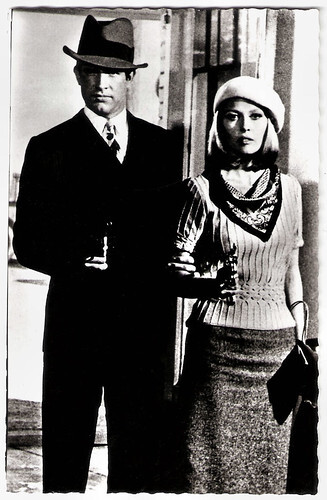
Dutch postcard. Photo: publicity still for Bonnie and Clyde (Arthur Penn, 1967) with Warren Beatty .
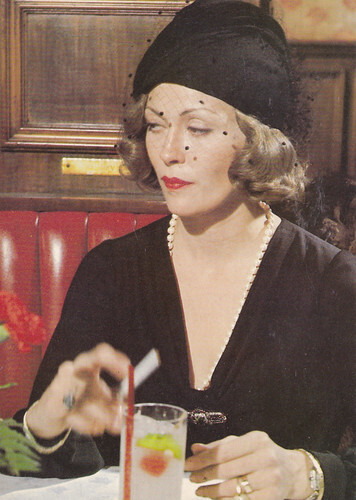
British postcard by Star-Graphics, London, no. S 118. Faye Dunaway in Chinatown (Roman Polanski, 1974). Collection: Carla Bosch.
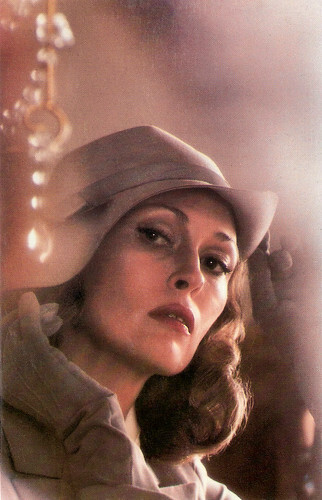
American postcard by Coral-Lee, Rancho Cordova, Ca., Personality #22, 1978. Photo: Douglas Kirkland.
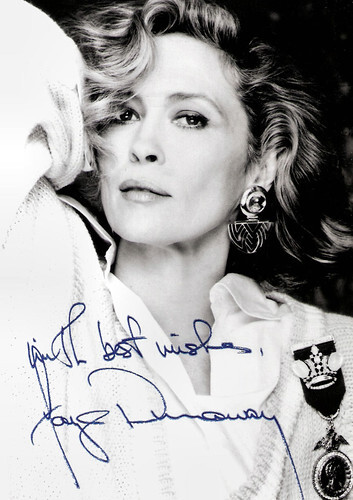
Autograph card.
Pop culture juggernaut
Dorothy Faye Dunaway was born on a farm in Bascom, Florida in 1941, the daughter of Grace April (Smith), a housewife, and John MacDowell Dunaway, Jr., an army officer. After high school she majored in education at the University of Florida, but switched to theatre arts and transferred to Boston University, earning her degree in 1962.
In 1962, at the age of 21, she took acting classes at the American National Theater and Academy. She did four plays on Broadway over the next three years. Her first screen appearance was on the short-lived TV drama series Seaway (1965). Dunaway's first film appearance was in The Happening (Elliot Silverstein, 1967), which starred Anthony Quinn . That role was followed by a supporting role in the drama Hurry Sundown (Otto Preminger, 1967), co-starring Michael Caine and Jane Fonda . While she had difficulties with Preminger, her performance was well-received and she was nominated for a Golden Globe Award for Best New Star of the Year.
Then she skyrocketed to fame as the bank robber Bonnie Parker in the pop culture juggernaut Bonnie and Clyde (Arthur Penn, 1967), with Warren Beatty . The film, though controversial, was a smash hit, and elevated Dunaway to stardom. For her part, Dunaway earned her first Academy Award nomination. She lost to Katherine Hepburn but won the BAFTA Award for Best Newcomer.
From then on she was in demand everywhere, holding her own against Steve McQueen in the caper film The Thomas Crown Affair (Norman Jewison, 1968). The film was immensely popular and was famed for a scene where Dunaway and McQueen play a chess game and silently engage in heavy seduction of each other across the board.
She then took on a role in the Italian film, Amanti/A Place for Lovers (Vittorio De Sica, 1968). Dunaway played a terminally ill fashion designer who has a doomed romance with an Italian race car driver ( Marcello Mastroianni ). Dunaway and Mastroianni fell in love in reality too and had a two-year affair.
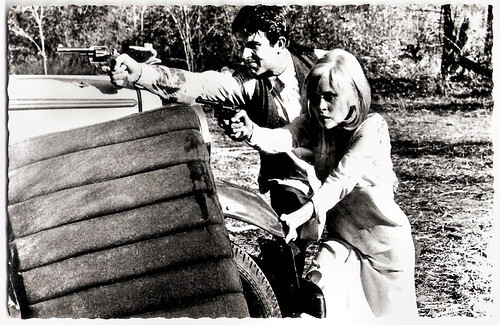
Dutch postcard. Photo: publicity still for Bonnie and Clyde (Arthur Penn, 1967) with Warren Beatty .

Canadian postcard by Canadian Postcard, no. A-18. Photo: Columbia TriStar. Gene Hackman , Estelle Parsons, Warren Beatty , Faye Dunaway and Michael J. Pollard in Bonnie and Clyde (Arthur Penn, 1967).
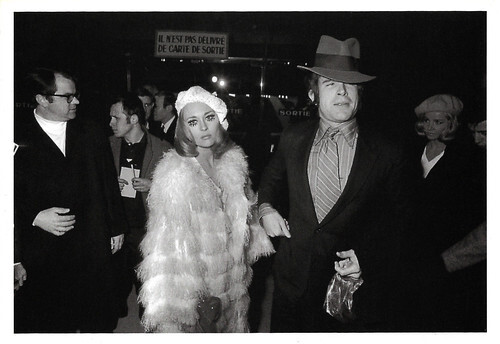
French postcard by Editions Hazan, 1996. Photo: Raymond Depardon. Faye Dunaway and Warren Beatty at the premiere of Bonnie and Clyde (Arthur Penn, 1967).
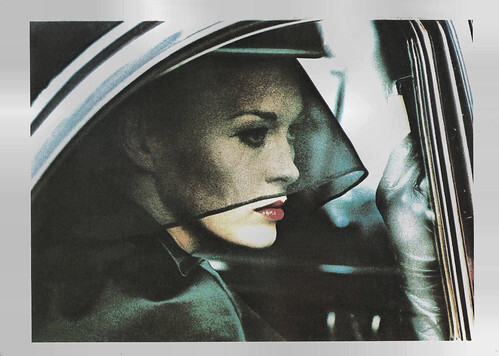
French postcard by Editions La Malibran, Paris / Saint-Dié, no. MC 14. Faye Dunaway in Puzzle of a Downfall Child (Jerry Schatzberg, 1970). The French title was Portait d'une enfant déchue.
A shadowy femme fatale
Faye Dunaway had another success with the villainous role of Milady de Winter in an all-star adaptation of Alexandre Dumas ' The Three Musketeers, starring Michael York , Oliver Reed , Richard Chamberlain, Raquel Welch , and Dunaway. After filming, the makers decided to split the film into two parts: The Three Musketeers (Richard Lester, 1973) and The Four Musketeers (Richard Lester, 1974). Critics and audiences alike praised the film for its action and its comic tone, and it was the first in a line of successful projects for Dunaway.
Roman Polanski offered Dunaway the lead role of Evelyn Mulwray in his mystery Neo-Noir Chinatown (1974). Mulwray is a shadowy femme fatale who knows more than she is willing to let Detective J.J. Gittes (played by Jack Nicholson ) know. The film made back its budget almost five times and received 11 Academy Award nominations. Dunaway received a second Best Actress nomination and also received a Golden Globe nomination and a BAFTA nomination.
Dunaway's next project was the all-star disaster epic The Towering Inferno (John Guillermin, 1974). She played the role of Paul Newman 's girlfriend, who is trapped in a burning skyscraper along with several other hundred people. The film became the highest-grossing film of the year, further cementing Dunaway as a top actress in Hollywood.
It was also in 1974 that Dunaway married Peter Wolf, who was the lead singer of the rock group The J. Geils Band. In 1975, Dunaway joined Robert Redford in the political thriller Three Days of the Condor (Sydney Pollack, 1975). A significant critical and commercial success, the film continues to be praised. Dunaway's performance was very well regarded.
In 1976 she finally won the Oscar for the satire Network (Sidney Lumet, 1976) as the scheming TV executive Diana Christensen, a ruthless woman who will do anything for higher ratings. She returned to the screen in Eyes of Laura Mars (John Carpenter, 1978), a thriller about a fashion photographer who sees visions of a killer murdering people.
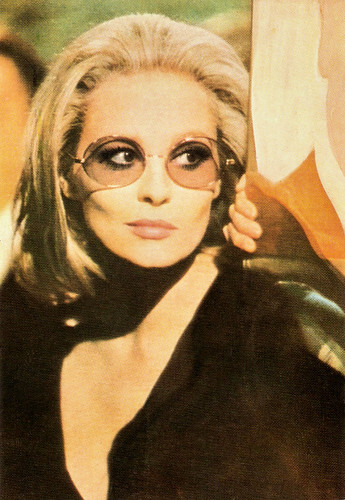
Romanian postcard by Casa Filmului Acin, no. 33132. Photo: publicity still for The Arrangement (Elia Kazan, 1969).
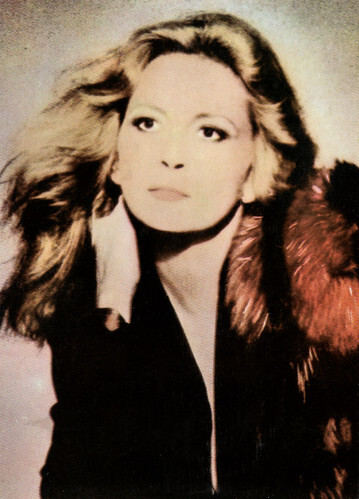
Romanian postcard by Casa Filmului Acin, no. 43 139.

French postcard in the Collection Magie Noire by Editions Hazan, Paris, no. 6250. Photo: Edimedia. Faye Dunaway in Eyes of Laura Mars (John Carpenter, 1978).
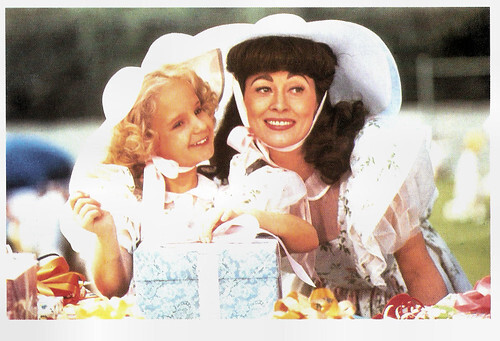
Italian postcard by TV Film. Photo: Faye Dunaway as Joan Crawford and Mara Hobel as little Christina Crawford in Mommie Dearest (Frank Perry, 1981).
No wire hangers, ever!
Faye Dunaway's tour de force as Joan Crawford in Mommie Dearest (Frank Perry, 1981) marked her last chapter as a top-tier actress. The film is an adaptation of Christina Crawford's controversial memoir, Mommie Dearest. Christina Crawford's book depicted her adopted mother as an abusive tyrant, who only adopted her four children to promote her career, and it made quite a stir as the first celebrity tell-all book. Though the film was poorly received by the critics at the time, Dunaway's performance received mixed reviews. The film was later seen as a camp classic. The American Film Institute named Dunaways' interpretation to be one of the greatest villainous characters in cinema history and the infamous line, "No wire hangers, ever!" to be one of the most memorable film quotes of all time.
After a remake of The Wicked Lady (Michael Winner, 1983), Dunaway played another villain in the superhero film, Supergirl (Jeannot Szwarc, 1984). Both films flopped. A late-career highlight came with the critically acclaimed drama Barfly (Barbet Schroeder, 1987), a semi-autobiography of poet/author Charles Bukowski (played by Mickey Rourke ) during the time he spent drinking heavily in Los Angeles. From then on she appeared in several independent films. She appeared with Joe Mantegna and Ornella Muti in Wait Until Spring, Bandini (Dominique Deruddere, 1989) and with Robert Duvall and Natasha Richardson in The Handmaid's Tale (Volker Schlöndorff, 1990).
Then followed the sequel to Chinatown (1974), The Two Jakes (1990), directed by and starring Jack Nicholson . The film was not a box office or critical success. She starred alongside Johnny Depp and Jerry Lewis in Serbian director Emir Kusturica's surreal comedy-drama Arizona Dream (1993). Dunaway also appeared with Depp and Marlon Brando in the romantic comedy Don Juan DeMarco (Jeremy Leven, 1995). A hit at the box office, the film was praised for its romance and the performances of the three main characters.
She returned to the stage in 1996, playing famed opera singer Maria Callas in the Tony Award-winning play Master Class by Terrence McNally. Dunaway toured the play throughout the United States. Dunaway was nominated for a Golden Raspberry Award as Worst Supporting Actress for her part in the crime thriller Albino Alligator (Kevin Spacey, 1997) with Matt Dillon . In 1998, she starred with Angelina Jolie in Gia (Michael Christofer, 1998), about the tragic life of model Gia Marie Carangi, which would win Dunaway a third Golden Globe and win Jolie both a Golden Globe and an Emmy.
Faye Dunaway played a small part in the remake of The Thomas Crown Affair (John McTiernan, 1999) with Pierce Brosnan . In 2002, she played Ian Somerhalder's mother in The Rules of Attraction (Roger Avary, 2002), based on the novel by Bret Easton Ellis. She continues to act, mostly in B-films and European films like the campy British horror film Flick (David Howard, 2008) and the Polish thriller Balladyna/The Bait (Dariusz Zawiślak, 2009). After her divorce from Peter Wolf in 1979, Faye Dunaway was married from 1983 to 1987 to British photographer Terry O'Neill. She and O'Neill have one child, Liam O'Neill (1980). In 2003, despite Dunaway's earlier claims that she had given birth to Liam, Terry claimed that Liam was adopted. Over the past years, she starred in such films as The Case for Christ (Jon Gunn, 2017), the thriller The American Connection (Jeff Espanol, 2021) and L'uomo che disegnò Dio/The Man Who Drew God (Franco Nero, 2022), with Kevin Spacey and Franco Nero .
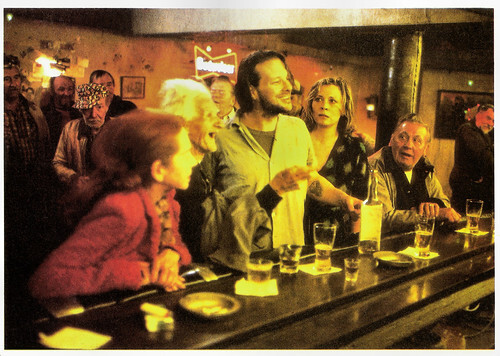
French postcard by Editions La Malibran, Paris, no. MC 29, 1989. Photo: Collection Cinéma Couleur. Mickey Rourke and Faye Dunaway in Barfly (Barbet Schroeder, 1987).
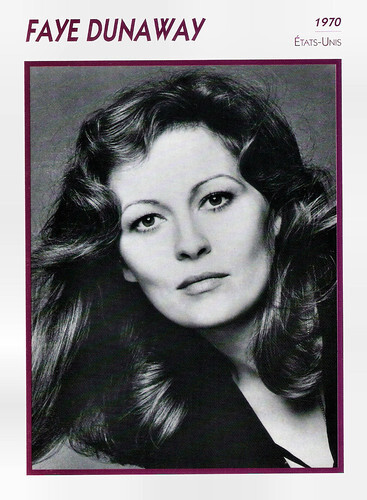
French collectors card in the 'Portrait de Stars - L'encyclopédie du Cinema' series by Edito-Service S.A., 1991. Photo: Koball Collection.
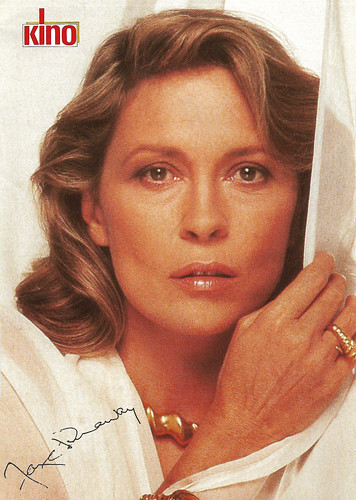
German autograph card by Kino, ca. 1988.
Trailer for Wait Until Spring, Bandini (1989). Source: Ximon NL (YouTube).
Sources: Wikipedia and .

Dutch postcard. Photo: publicity still for Bonnie and Clyde (Arthur Penn, 1967) with Warren Beatty .

British postcard by Star-Graphics, London, no. S 118. Faye Dunaway in Chinatown (Roman Polanski, 1974). Collection: Carla Bosch.

American postcard by Coral-Lee, Rancho Cordova, Ca., Personality #22, 1978. Photo: Douglas Kirkland.

Autograph card.
Pop culture juggernaut
Dorothy Faye Dunaway was born on a farm in Bascom, Florida in 1941, the daughter of Grace April (Smith), a housewife, and John MacDowell Dunaway, Jr., an army officer. After high school she majored in education at the University of Florida, but switched to theatre arts and transferred to Boston University, earning her degree in 1962.
In 1962, at the age of 21, she took acting classes at the American National Theater and Academy. She did four plays on Broadway over the next three years. Her first screen appearance was on the short-lived TV drama series Seaway (1965). Dunaway's first film appearance was in The Happening (Elliot Silverstein, 1967), which starred Anthony Quinn . That role was followed by a supporting role in the drama Hurry Sundown (Otto Preminger, 1967), co-starring Michael Caine and Jane Fonda . While she had difficulties with Preminger, her performance was well-received and she was nominated for a Golden Globe Award for Best New Star of the Year.
Then she skyrocketed to fame as the bank robber Bonnie Parker in the pop culture juggernaut Bonnie and Clyde (Arthur Penn, 1967), with Warren Beatty . The film, though controversial, was a smash hit, and elevated Dunaway to stardom. For her part, Dunaway earned her first Academy Award nomination. She lost to Katherine Hepburn but won the BAFTA Award for Best Newcomer.
From then on she was in demand everywhere, holding her own against Steve McQueen in the caper film The Thomas Crown Affair (Norman Jewison, 1968). The film was immensely popular and was famed for a scene where Dunaway and McQueen play a chess game and silently engage in heavy seduction of each other across the board.
She then took on a role in the Italian film, Amanti/A Place for Lovers (Vittorio De Sica, 1968). Dunaway played a terminally ill fashion designer who has a doomed romance with an Italian race car driver ( Marcello Mastroianni ). Dunaway and Mastroianni fell in love in reality too and had a two-year affair.

Dutch postcard. Photo: publicity still for Bonnie and Clyde (Arthur Penn, 1967) with Warren Beatty .

Canadian postcard by Canadian Postcard, no. A-18. Photo: Columbia TriStar. Gene Hackman , Estelle Parsons, Warren Beatty , Faye Dunaway and Michael J. Pollard in Bonnie and Clyde (Arthur Penn, 1967).

French postcard by Editions Hazan, 1996. Photo: Raymond Depardon. Faye Dunaway and Warren Beatty at the premiere of Bonnie and Clyde (Arthur Penn, 1967).

French postcard by Editions La Malibran, Paris / Saint-Dié, no. MC 14. Faye Dunaway in Puzzle of a Downfall Child (Jerry Schatzberg, 1970). The French title was Portait d'une enfant déchue.
A shadowy femme fatale
Faye Dunaway had another success with the villainous role of Milady de Winter in an all-star adaptation of Alexandre Dumas ' The Three Musketeers, starring Michael York , Oliver Reed , Richard Chamberlain, Raquel Welch , and Dunaway. After filming, the makers decided to split the film into two parts: The Three Musketeers (Richard Lester, 1973) and The Four Musketeers (Richard Lester, 1974). Critics and audiences alike praised the film for its action and its comic tone, and it was the first in a line of successful projects for Dunaway.
Roman Polanski offered Dunaway the lead role of Evelyn Mulwray in his mystery Neo-Noir Chinatown (1974). Mulwray is a shadowy femme fatale who knows more than she is willing to let Detective J.J. Gittes (played by Jack Nicholson ) know. The film made back its budget almost five times and received 11 Academy Award nominations. Dunaway received a second Best Actress nomination and also received a Golden Globe nomination and a BAFTA nomination.
Dunaway's next project was the all-star disaster epic The Towering Inferno (John Guillermin, 1974). She played the role of Paul Newman 's girlfriend, who is trapped in a burning skyscraper along with several other hundred people. The film became the highest-grossing film of the year, further cementing Dunaway as a top actress in Hollywood.
It was also in 1974 that Dunaway married Peter Wolf, who was the lead singer of the rock group The J. Geils Band. In 1975, Dunaway joined Robert Redford in the political thriller Three Days of the Condor (Sydney Pollack, 1975). A significant critical and commercial success, the film continues to be praised. Dunaway's performance was very well regarded.
In 1976 she finally won the Oscar for the satire Network (Sidney Lumet, 1976) as the scheming TV executive Diana Christensen, a ruthless woman who will do anything for higher ratings. She returned to the screen in Eyes of Laura Mars (John Carpenter, 1978), a thriller about a fashion photographer who sees visions of a killer murdering people.

Romanian postcard by Casa Filmului Acin, no. 33132. Photo: publicity still for The Arrangement (Elia Kazan, 1969).

Romanian postcard by Casa Filmului Acin, no. 43 139.

French postcard in the Collection Magie Noire by Editions Hazan, Paris, no. 6250. Photo: Edimedia. Faye Dunaway in Eyes of Laura Mars (John Carpenter, 1978).

Italian postcard by TV Film. Photo: Faye Dunaway as Joan Crawford and Mara Hobel as little Christina Crawford in Mommie Dearest (Frank Perry, 1981).
No wire hangers, ever!
Faye Dunaway's tour de force as Joan Crawford in Mommie Dearest (Frank Perry, 1981) marked her last chapter as a top-tier actress. The film is an adaptation of Christina Crawford's controversial memoir, Mommie Dearest. Christina Crawford's book depicted her adopted mother as an abusive tyrant, who only adopted her four children to promote her career, and it made quite a stir as the first celebrity tell-all book. Though the film was poorly received by the critics at the time, Dunaway's performance received mixed reviews. The film was later seen as a camp classic. The American Film Institute named Dunaways' interpretation to be one of the greatest villainous characters in cinema history and the infamous line, "No wire hangers, ever!" to be one of the most memorable film quotes of all time.
After a remake of The Wicked Lady (Michael Winner, 1983), Dunaway played another villain in the superhero film, Supergirl (Jeannot Szwarc, 1984). Both films flopped. A late-career highlight came with the critically acclaimed drama Barfly (Barbet Schroeder, 1987), a semi-autobiography of poet/author Charles Bukowski (played by Mickey Rourke ) during the time he spent drinking heavily in Los Angeles. From then on she appeared in several independent films. She appeared with Joe Mantegna and Ornella Muti in Wait Until Spring, Bandini (Dominique Deruddere, 1989) and with Robert Duvall and Natasha Richardson in The Handmaid's Tale (Volker Schlöndorff, 1990).
Then followed the sequel to Chinatown (1974), The Two Jakes (1990), directed by and starring Jack Nicholson . The film was not a box office or critical success. She starred alongside Johnny Depp and Jerry Lewis in Serbian director Emir Kusturica's surreal comedy-drama Arizona Dream (1993). Dunaway also appeared with Depp and Marlon Brando in the romantic comedy Don Juan DeMarco (Jeremy Leven, 1995). A hit at the box office, the film was praised for its romance and the performances of the three main characters.
She returned to the stage in 1996, playing famed opera singer Maria Callas in the Tony Award-winning play Master Class by Terrence McNally. Dunaway toured the play throughout the United States. Dunaway was nominated for a Golden Raspberry Award as Worst Supporting Actress for her part in the crime thriller Albino Alligator (Kevin Spacey, 1997) with Matt Dillon . In 1998, she starred with Angelina Jolie in Gia (Michael Christofer, 1998), about the tragic life of model Gia Marie Carangi, which would win Dunaway a third Golden Globe and win Jolie both a Golden Globe and an Emmy.
Faye Dunaway played a small part in the remake of The Thomas Crown Affair (John McTiernan, 1999) with Pierce Brosnan . In 2002, she played Ian Somerhalder's mother in The Rules of Attraction (Roger Avary, 2002), based on the novel by Bret Easton Ellis. She continues to act, mostly in B-films and European films like the campy British horror film Flick (David Howard, 2008) and the Polish thriller Balladyna/The Bait (Dariusz Zawiślak, 2009). After her divorce from Peter Wolf in 1979, Faye Dunaway was married from 1983 to 1987 to British photographer Terry O'Neill. She and O'Neill have one child, Liam O'Neill (1980). In 2003, despite Dunaway's earlier claims that she had given birth to Liam, Terry claimed that Liam was adopted. Over the past years, she starred in such films as The Case for Christ (Jon Gunn, 2017), the thriller The American Connection (Jeff Espanol, 2021) and L'uomo che disegnò Dio/The Man Who Drew God (Franco Nero, 2022), with Kevin Spacey and Franco Nero .

French postcard by Editions La Malibran, Paris, no. MC 29, 1989. Photo: Collection Cinéma Couleur. Mickey Rourke and Faye Dunaway in Barfly (Barbet Schroeder, 1987).

French collectors card in the 'Portrait de Stars - L'encyclopédie du Cinema' series by Edito-Service S.A., 1991. Photo: Koball Collection.

German autograph card by Kino, ca. 1988.
Trailer for Wait Until Spring, Bandini (1989). Source: Ximon NL (YouTube).
Sources: Wikipedia and .
Published on March 07, 2024 22:00
Paul van Yperen's Blog
- Paul van Yperen's profile
- 13 followers
Paul van Yperen isn't a Goodreads Author
(yet),
but they
do have a blog,
so here are some recent posts imported from
their feed.



